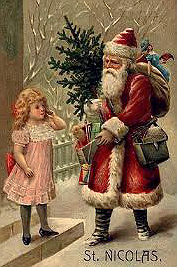Arlene Stafford-Wilson's Blog, page 36
December 17, 2021
Allan House & Cecil Hotel Perth
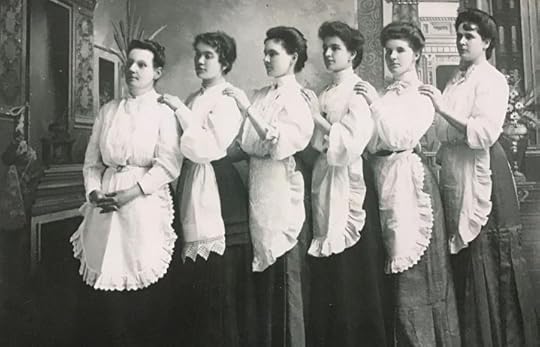
Dining staff at the Allan House Hotel – Second from the right -Anne Trainor (Kerr), her sister is in the middle. Lizzie Trainor (Menagh), daughters of Michael Trainor and Mary Laughney, c. 1900, Photo: courtesy of Shirley (Kerr) Scott
Allan House
The building was erected in 1845 by John McCallum. In its glory days, Allan House was the largest hotel in Perth, with fifty well-appointed rooms. Owner and operator, Andrew Robinson, was known for his hospitality and he offered free buggy rides to the train and stages.
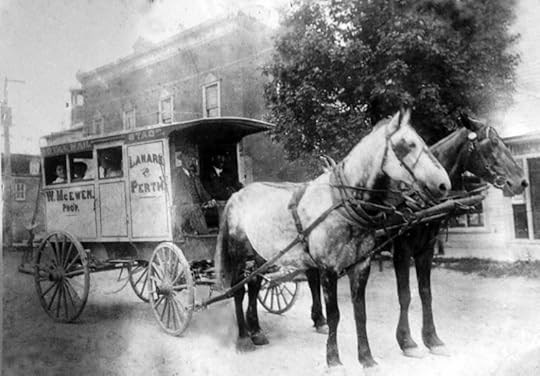
photo: Middleville Museum, c. 1900
William McEwen operated the horse-drawn taxi which departed from the Allan House every day except Sunday. The fare was thirty-five cents to Balderson and sixty-five cents to Lanark.
The popular hotel was sold in the fall of 1911 to Mr. Fitzgerald of Almonte, and the name was officially changed on November 1, 1911 to the ‘Hotel Cecil’
Hotel Cecil
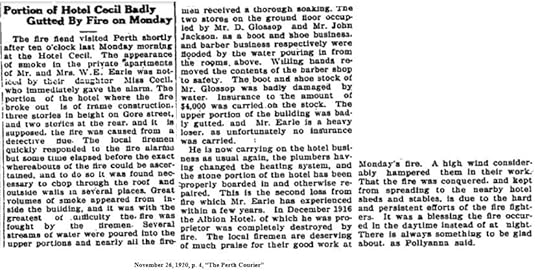
Death in the Laundry Room
Just a few days before Christmas – one month after the Fitzgerald brothers took over the hotel, tragedy struck, when Rose O’Neil collapsed suddenly, while working in the laundry room of the hotel, and died. She was a daughter of Francis O’Neil of Burgess Township.
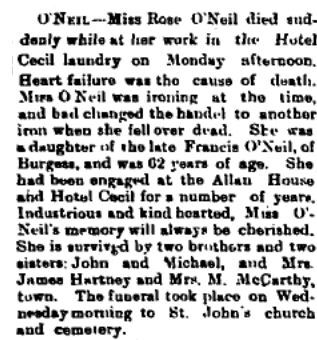
Dec. 22, 1911, p. 1, “The Perth Courier”
There were several fires in the building over the years – in 1920, in 1924, and in 1972.

1972 Fire
Residents Escape
In Night Attire
“It was a miracle that no one was killed or seriously injured in the $250,000 fire which swept through the stone building on Gore Street E., near the Town Hall, early Monday morning.
The business and apartment block, owned by Leslie Campbell of Ottawa, was purchased by him just twelve months ago.
The two-storey apartment building, along with a penthouse, was occupied by elderly people, who came to near-panic when the alarm sounded and they found the stairs and halls were filled with smoke.
One lady was carried down from a verandah on the back of a fireman, while another was rescued from a second-storey window. The remainder were led through the smoke by police and firemen and lost all their furniture and private possessions.
Gerald Dean, who was driving south on Gore Street at 3:30 a.m. noticed smoke drifting across the street. He turned on Market to the rear of the premises and saw that the tinsmith’s shop was a mass of flames.
He immediately ran over to the police station and notified Constable Dulmage, who was on duty at the time.
The Constable handed Dean the fire extinguisher while he sounded the fire alarm.
On returning to the scene of the fire, he found the windows of the tinsmiths’s shop were broken, probably due to the intense heat. At that time, he said the blaze seemed to be confined to that one area.
The fire department was on the scene very quickly and Mr. Dean decided to go home to bed, as he thought it was only a small fire.
When he woke at 7 a.m. he was amazed to see the whole building gutted.
In an interview, he said he saw nothing that would indicate how the fire had started.
Firemen from Smiths Falls, Almonte, and Lanark, along with the rural township firemen, helped to quell the blaze.
Four businesses, Thomas Hardware, Avco Finance, a coin laundry and a recently-renovated Eaton’s order office were gutted by the fire. All the contents and records were completely destroyed.
Constable Dulmage went to the Gore Street entrance of the building to arouse the residents on the second floor along with Robert Scobbie of Perth, who had heard the fire alarm and came to help.
The Constable said, “I could see the doors of the apartments when we climbed the stairs and entered the corridor. We banged on the doors and the elderly residents, unaware of the fire, came out in their night attire.
“We led them down the stairs and the smoke was so thick we had to feel our way to safety.”
The residents were then directed to the Town Hall where their relatives were notified and came to give them shelter in their homes.
“To make sure no one was left in the buildings, Scobbie raced back into the smoke-filled apartments for a final check.”
As conditions grew worse, he (Scobbie) found himself stranded and had to make his way out of the building by smashing a window on the second floor.
The brave young man was rescued by Constable Dulmage who heard the crash of glass and placed a ladder up to the window.
The Salvation Army officers were at the scene very quickly to serve hot drinks and sandwiches to the firemen. Nelson King, a local merchant, also served hot coffee during the early hours of the morning.
Firemen Injured
Two firemen, Deputy-Chief David Bell and Ron Jenkins, were taken to hospital for treatment after being cut by flying glass when an explosion took place at approximately 5:45 a.m., in the Avco offices. This is believed to have been caused by combustion building up in the offices, which ran the width of the buildings.
Fire Chief, Jack Andison said, “We were very fortunate to stop the fire from spreading to the attached apartment building. We had problems in fighting the fire due to some old wooden buildings being adjacent to the destroyed portion.”, he said.
The Chief said that the Perth Utilities bucket truck had played an important part in keeping the fire under control, as it was used to lift firemen and hoses to the roof of the building so water could be poured down from an overhead position.
Later, the Almonte Fire Department came to their assistance with an aerial ladder.
At about 6 a.m., the Chief explained, flames were shooting from the second and third storey windows, and the fire spread through the attic and into the tar and gravel roof of the building.
According to a report, the tinsmiths’s shop, owned by Roy Kilpatrick, was securely locked
by Clyde Emerson as he left the building at 9:30 a.m. on Saturday morning. He was believed to have been the last person in the tinsmith’s shop.
Electric Short
The fire is believed to have been caused by an electric short.
The staff of the Ottawa Gas Co. was called to the scene and turned off the feeder line to the Coin Wash at 6:30 a.m. All pipes were found to be undamaged and intact.
In an interview with Mr. Campbell, the owner of the building, he said he was called to the fire early in the morning and the gutting of the building was a complete shock to him.
“At the present time,”, he said, “I cannot make any decision with regard to re-building. But I will definitely clean everything up as soon as possible.” The building is believed to be insured for $100,000.
Perth Town Council will be sending letters of citation to Constable Richard Dulmage and local resident, Robert Scobbie for the parts they played in rescuing the apartment tenants.
Letters of citation will also be sent to the local police department, Public Utilities Commission, fire department, and the three other fire departments which responded to the emergency.
Considerable smoke and water damage was done to the adjoining building, which houses DiCola Fuels, New Style Shoppe, and Haggis Candy Store.
All these stores are closed at present for clean-up operations.”
Thursday, November 30, 1972, “The Perth Courier”

Arlene Stafford-Wilson
December 15, 2021
St. Vincent de Paul Church – DeWitt’s Corners

Summer in the country was a time for swimming in the Tay River, hanging out with friends at the millstone at Cavanagh’s general store, and regular bike rides up and down the Third Line. There were farm tractors, hay-wagons, mothers outside hanging their washing on clotheslines, and daisies and black-eyed-Susans waving in the ditches, as I flew by on my old red bike.

I always passed by the familiar farms and houses along the way – Mitchell’s, Conboy’s, pedaled like lightning past Heney’s, so their dogs couldn’t catch me. I continued past Radford’s, Siebel’s, Mitchell’s, Kerr’s, Closs’, heading up the Third Line toward Kyle’s, Perkins’ and Doyle’s when one day, something unusual caught my eye.
A stylish wedding party was entering St. Vincent de Paul Church; a bride in a flowing white gown, three bridesmaids dressed in pastel pink, carrying matching nosegays. Several cars were parked outside, decorated with pink and white tissue flowers. I pulled over to the side of the road to watch the procession. The old Catholic church had been around for as long as I could remember, and appeared as proud and majestic as ever on that hot summer day so long ago.
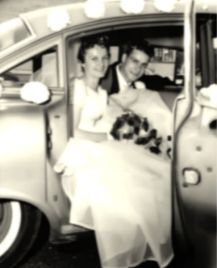
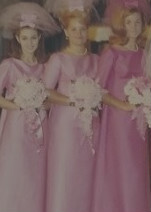
The early settlers in Bathurst Township were keen to have their own church, instead of driving to St. John’s Church in Perth, or St. Bridget’s Church in Stanleyville. Roads were treacherous at times in the winter, with deep snow, sometimes freezing rain, or both.
Long before St. Vincent de Paul Church was built, Roman Catholic services were held for 69 years, in the home of Mrs. Ed. Lee on the Third Line.
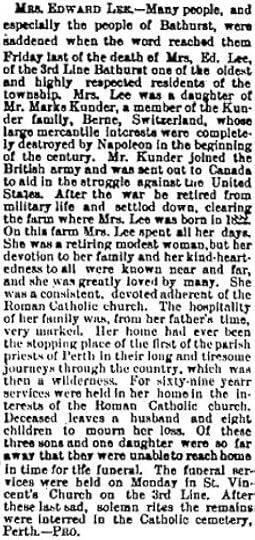
The people of Bathurst petitioned Bishop James Vincent Cleary for a church of their own. They needed a suitable, conveniently located place to erect a new church building.
John DeWitt, son of a pioneer settler, and his wife Mary Neil knew there was a need for a Roman Catholic Church to serve the growing community. Hoping to improve the situation, they made a promise to donate the land to build a church.
The paperwork was completed, and the land on lot 11, between the 2nd and 3rd concessions of Bathurst Township was donated by John and Mary DeWitt on July 26, 1889. To ensure that the transaction was legal, the land was sold for the token sum of one dollar to the Kingston Diocese of the Roman Catholic Church.
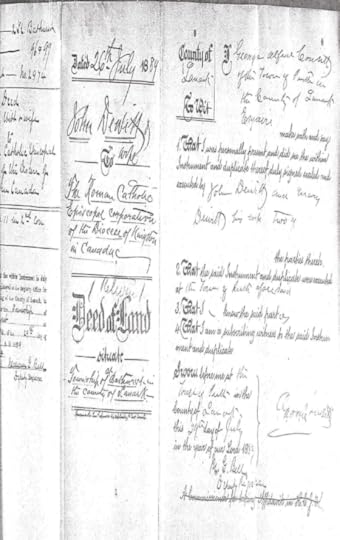
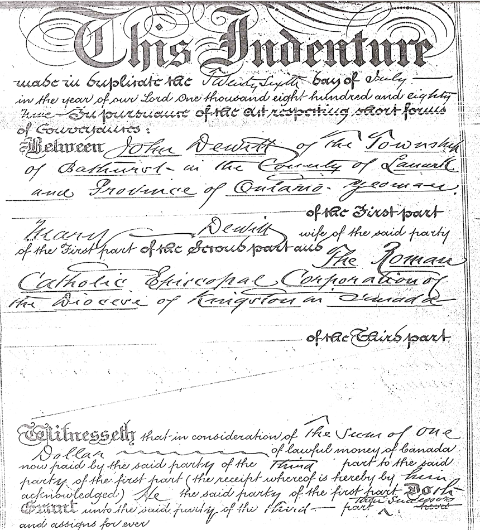
The construction progressed quickly, and the first mass was held on November 23, 1889. The church was packed that day, and this stately building has served generations of families around DeWitt’s Corners and the area for over 125 years and counting.
Pastors who have served St. Vincent de Paul:
Rev. T.P. O’Connor 1889-1899
Rev. John O’Brien – 1899-1901
Rev. J.H. McDonough – 1901-1912
Rev. P.J. Keaney – 1912-1917
Rev. J.J. Keeley – 1917-1926
Rev. J.V. Meagher – 1926-1928
Rev. L.B. Garvin – 1928-1934
Rev. Walter Whalen – 1934-1940
Rev. J.W. Callahan – 1940-1947
Rev. W.L. Terrion – 1947-1952
Rev. J.C. LeSage – 1952-1976
Father Karl Clemens – 1976 – 1983
Father Richard Whalen – 1983-1985
Father Liam Tallon – 1985 – 1993
Father Karl Clemens (back) – 1993 – 1998
Father Lindo Molon – 1998 – 2006
Father Mark Ruckpaul – 2006 – 2012
Father Aidan Dasaah – 2012 – 2014
Father Jan Kusyk – 2014 –
………………………………………………………………………………………………………………………………………………
One of the weddings in the early days of St. Vincent de Paul Church – Henry Edmund Hagan, son of Hugh Hagan and Agnes Bennett, Westport, married Anna Victoria Jackman Hagan, daughter of John Jackman and Matilda Nagle, Wemyss, on 25 September 1918. Henry was 25 and Anna was 17. (according to Richard Frizzell, their grandson on his mother’s side – ” Family history has it that she married so young in order to escape having to rear her 4 brothers and sisters after her mother passed away in 1916.”)
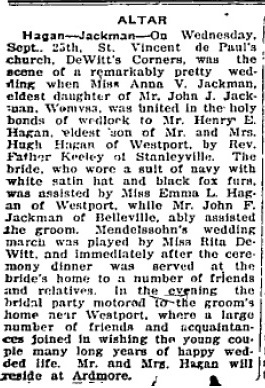
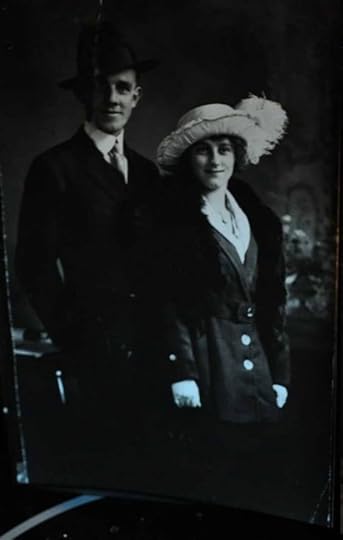
According to their grandson, Richard Frizell, “Henry and Anna farmed up on the mountain in Westport until 1956 or 57. They sold the farm and moved to Glen Tay. They had 5 children; my mom, Vera, was the oldest girl.”
……………………………………………………………………………………………………………………………………………
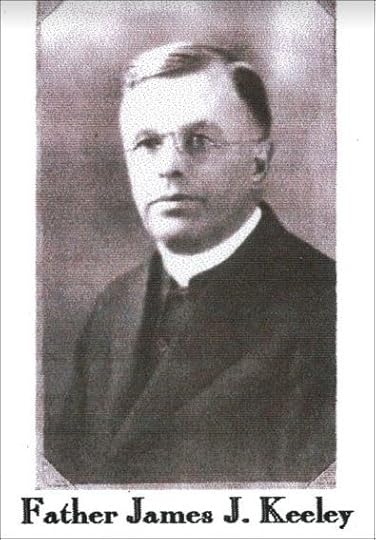
Father James Keeley – served St. Vicent de Paul from 1917-1926
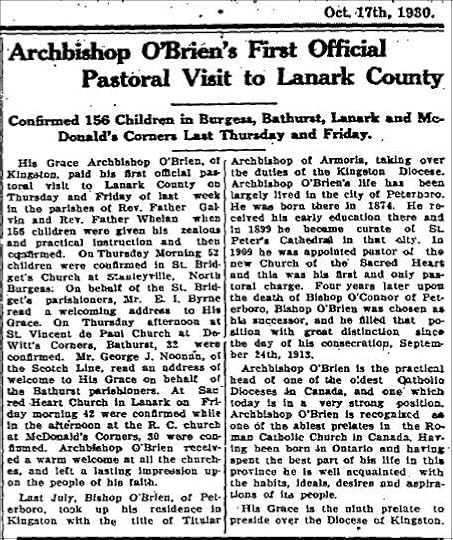
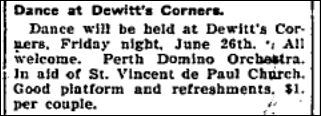
I recall that Father J.C. Le Sage was the Priest of the parish from 1952 through to 1976. Fr. Le Sage was well-liked, and a good friend to many of the local parishioners. He was known to be extremely intelligent, and it was widely believed that he had come from a very capable family. He had a reputation for being an excellent business manager, and ensured that the Church was in good repair.
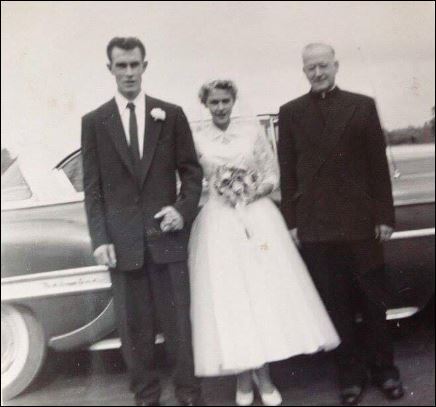
During his time serving at DeWitt’s Corners he hired an exceptionally talented Dutch painter who cleaned and restored the wood ceiling of St. Vincent’s, and painted the interior of the building. He was also instrumental in building a parish hall in Stanleyville (the Blessed Virgin Mary Parish Hall) to serve both parishes (St. Vincent de Paul in Dewitt’s Corners and St. Bridget’s in Stanleyville). Because of his excellent fiscal management, the total costs for the new hall were paid off quickly. Along with Fr. Le Sage’s sound business sense, an active Catholic Women’s League helped to raise money for the church, and assist with local charities.
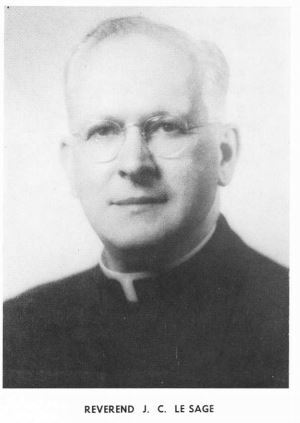
At the age of 67, Rev. Father LeSage suffered a heart attack at his home, near Stanleyville, and passed away on September 13, 1976.
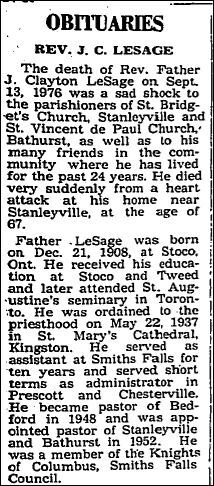

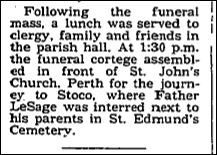
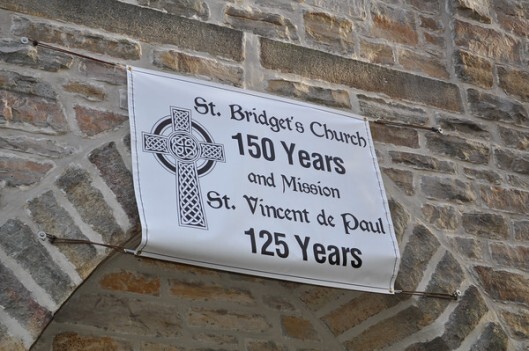
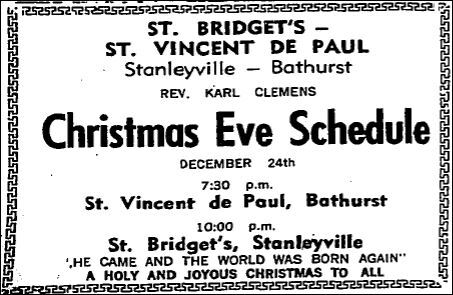
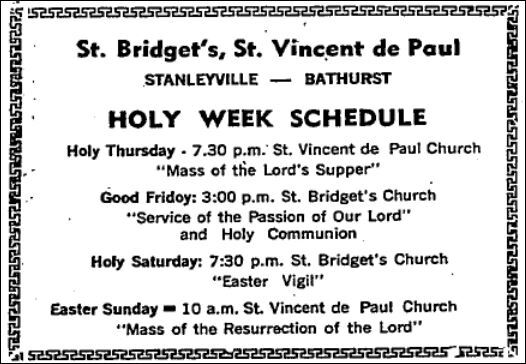
In 1979 the parishoners from DeWitt’s Corners and Stanleyville, sponsored a family of seven ‘Boat People’, who had fled their homeland for Canada.

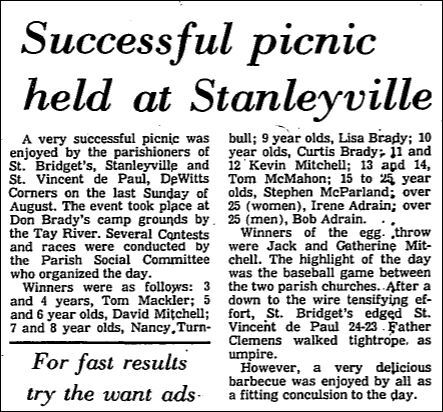

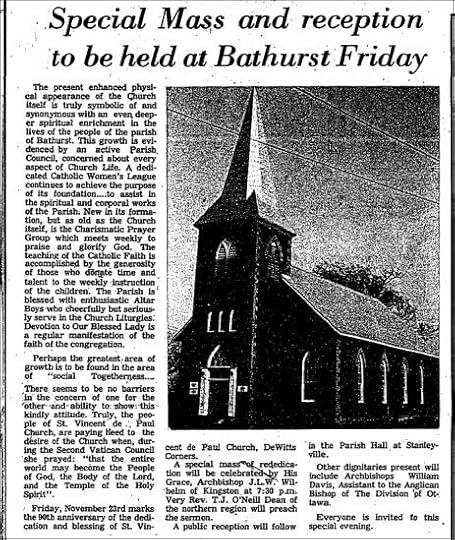
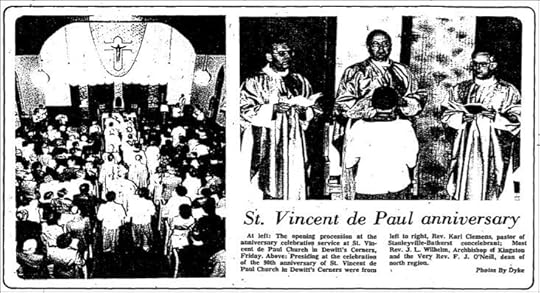
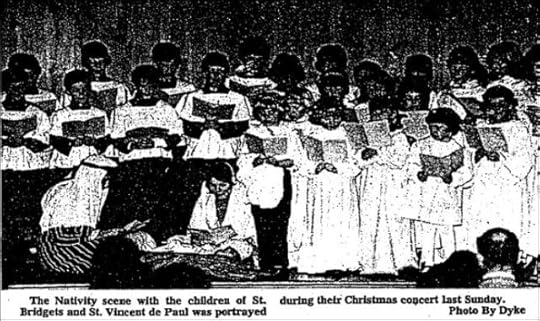
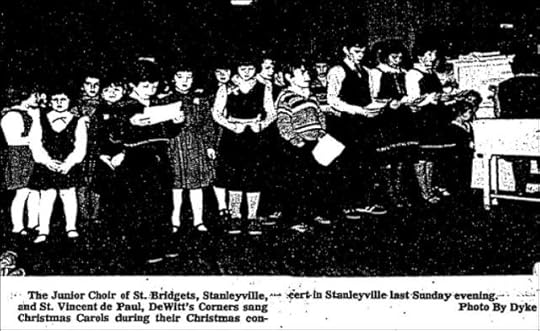

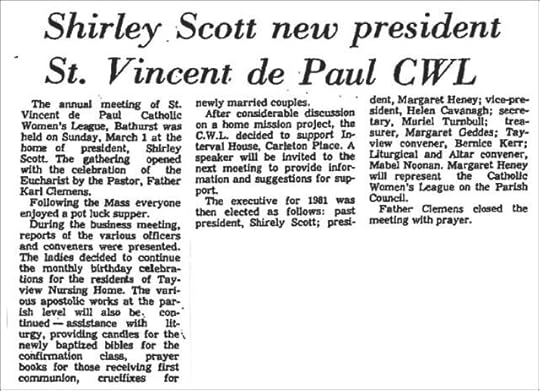
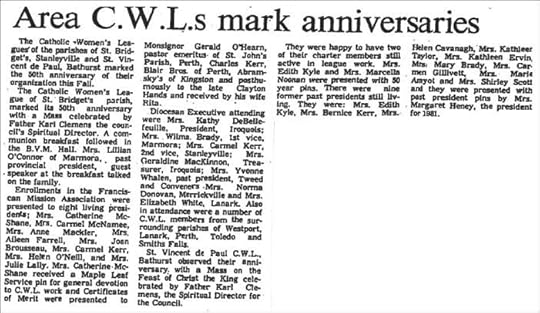
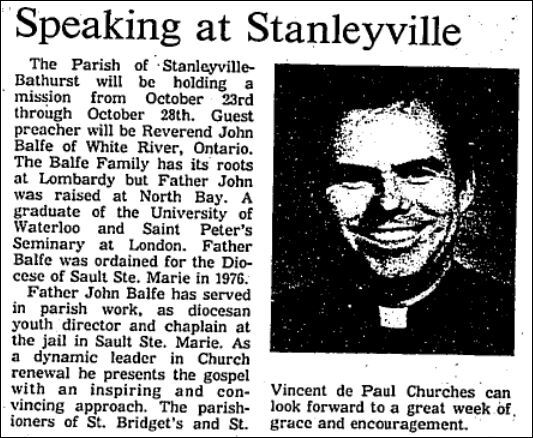
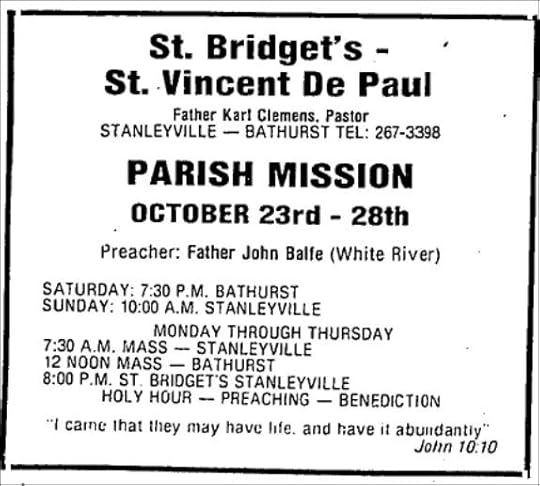 October 20, 1982 – Guest Speaker
October 20, 1982 – Guest Speaker
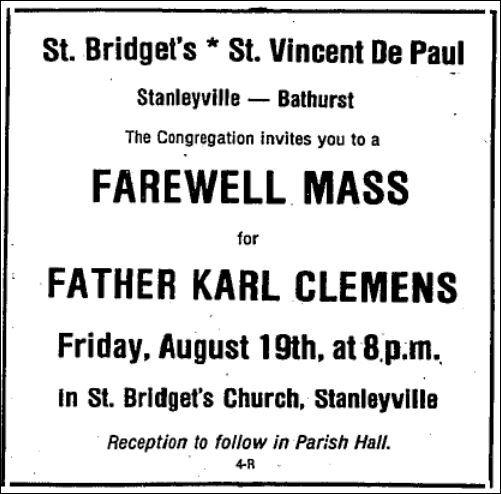
St. Vincent de Paul, the pretty red brick church at DeWitt’s Corners, has served the community for well over a century. Both residents and seasonal visitors from nearby cottages have found comfort and a sense of belonging, inside these stately walls.
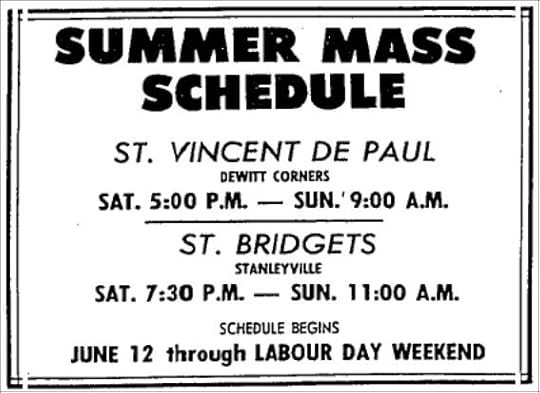
Many weddings, christenings, and funerals have taken place over the past hundred years, and to those of us who grew up in this neighbourhood, St. Vincent de Paul will always remain a memorable place, in our hearts.
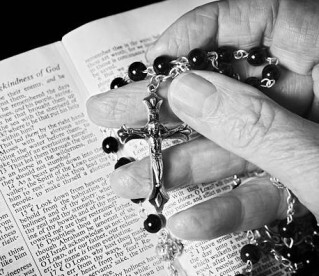
…………
photo of St. Vincent de Paul church c. 1970s, courtesy of JoAnne Cavanagh Butlerphoto of wedding -Peter and Mary McNamee 1955 with Father LeSage – courtesy of Mary McNameephoto of wedding – Henry Hagan, to Anna Jackman Hagan, and photo of Father Keeley- courtesy of Richard FrizellFor more about the history and days gone by in DeWitt’s Corners:
‘Lanark County Classics: A Treasury of Tales from Another Time”…………
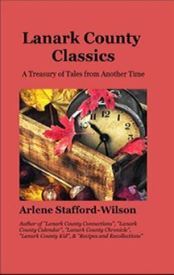
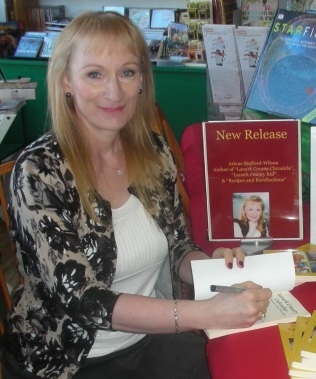
Arlene Stafford-Wilson
Chaplin’s Dairy – Christmas Eve
Dad was always late getting home on Christmas Eve. It had nothing to do with the weather, which was often unpredictable that time of year, with snowstorms or freezing rain. It was because he delivered milk for a living, and December 24th was the last time he’d see his customers on his milk route before Christmas Day. Chaplin’s Dairy was closed December 25th.
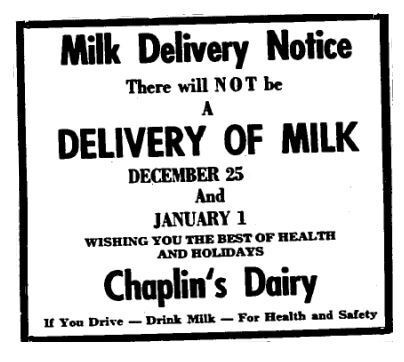
For a man who wasn’t particularly outgoing, more of the strong silent type, he still managed to make a lot of friends, and was well-liked by his customers, and that was a big part of the reason he was late on Christmas Eve. In fact, he wasn’t just late toward the end of his route, he was late all day; losing a few minutes here, and a few minutes there, spending extra time with each customer, until, by the end of his route, he was running very late indeed.
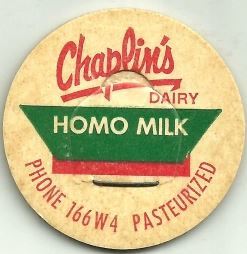
It wasn’t something to complain about. Dad’s customers made a point of greeting him at the door on December 24th; the same people who would often leave a hastily scribbled note explaining how much milk they wanted, and sometimes the money they owed was left with the note, on their front steps, or between the doors, or stuck in an empty milk bottle. Christmas Eve was different. Dad’s customers not only came to the door when he knocked, but they presented him with boxes of peppermint patties, and chocolate covered maraschino cherries, packs of cigarettes, Christmas cards with one or two dollar bills inside. They made a point of shaking his hand, wished him a Merry Christmas, and thanked him for bringing their milk all year.
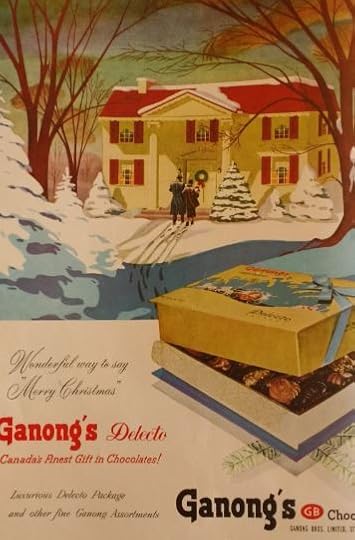
Long after nightfall, when he finally finished delivering to his last customer in Perth, he drove the big rattling pink and white Chaplin’s Dairy truck back to Glen Tay, then unloaded all of the empty milk bottles, brought them into the dairy, got in his car, and drove home.
He was always late for supper, and some years we waited….and waited…., but more often, Mother would just give up after an hour or so, and put his dinner in the oven to keep it warm. We were all busy, running around getting ready to go to Calvin Church for candlelight services, so Dad would often have to fend for himself when he finally arrived.
If I close my eyes, I can still see him, heading across the snowy yard, laden down with bags and boxes filled with chocolates, gifts, and cards from his customers. He’d stop just before he reached the house, set everything down, and plug in the Christmas lights that were wound around the snowy spruce tree beside the house.
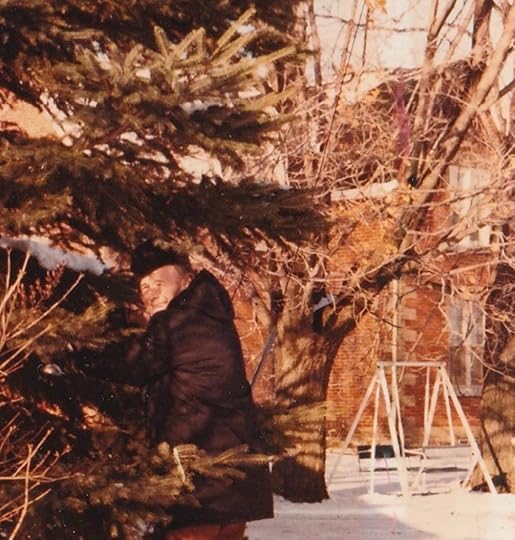
He never forgot the kindness and generosity of the customers on his route, and when he’d open a box of chocolates he’d remark, “these are from the Murphy family”, or “the peppermint patties are from my customer, Mrs. Ferguson, on Sherbrooke Street. He displayed all of their Christmas cards proudly – some on top of the old black and white television, and some on the shelves of the china cabinet, and he placed the one and two dollar bills in an envelope and handed them to Mother, who saved them to use toward something practical.
As the days grow shorter and colder, and the long shadows stretch across the sky earlier each afternoon, I remember those Christmas Eves, waiting for Dad to come home. At the time it seemed like a bother, squirming in our chairs, growing impatient for our supper, and wanting the evening to be over quickly so the morning would come, and we could open our gifts, and see what Santa had left in our stockings.
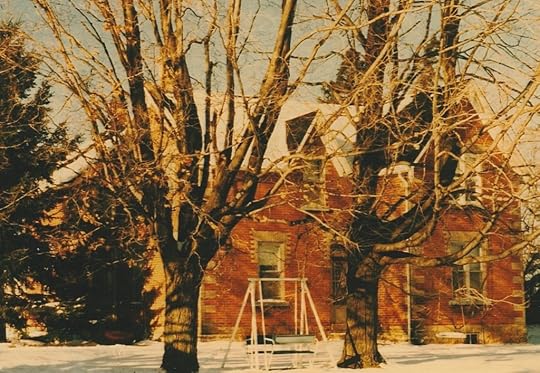
It’s only now, many years later, that I realize what a special day December 24th must have been for Dad, to be greeted so kindly, to be showered with gifts, to listen to the expressions of heartfelt gratitude, the sincere appreciation, along with the warm handshakes and genuine best wishes for a happy Christmas. The fact that his customers took the time and expense to gift him with boxes of chocolates, cards and the one or two dollar bills meant the world to him. Dad told us that some of his customers were of modest means, and could scarcely afford the milk he delivered each day, let alone a gift for their milkman.
Looking back it was things like this that made Christmas special – meals made with love for all to share, the homemade ornaments gracing the tree, carols sung by candlelight at Calvin Church, the scent of the fresh spruce in the living room, and seeing our Dad beaming with pride as he passed around box after box of delicious chocolates, a gift of gratitude, for a job well done, and with warmest good wishes for a Merry Christmas.
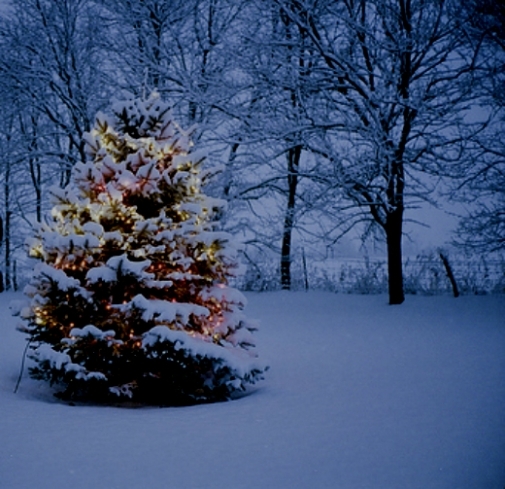

For more about Chaplin’s Dairy
Chaplin’s Dairy in Glen Tay:
Chaplin’s Dairy in Glen Tay
also
A story about Chaplin’s Dairy, in “Lanark County Kid”:
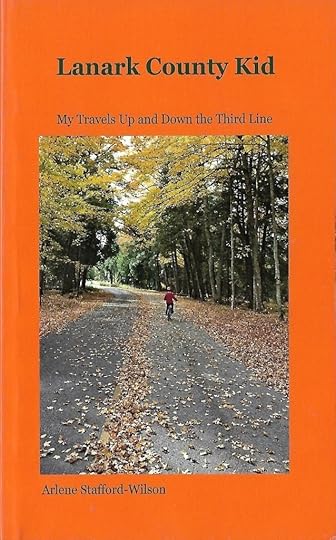
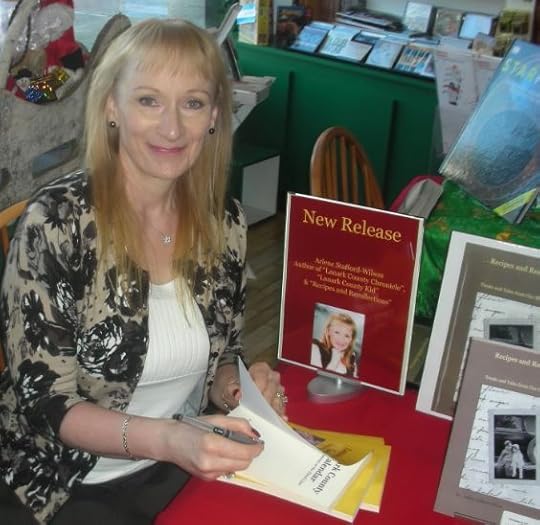
Arlene Stafford-Wilson
December 14, 2021
Christmas Traditions of Our Ancestors
Ever wonder why we bring a tree into our homes or why we adorn it with lights and tinsel? Why do we hang a stocking? How did egg nog become a beverage associated with the festive season? When did a white haired man in a red suit begin to deliver gifts to children? Why do we eat turkey and stuffing? Why do we buy gifts for each other?
There are countless traditions and customs practised throughout the world at this time of year. Most of these rituals have been passed down to us from our parents, grandparents and great-grandparents. We do these things each year without thinking. Our ancestors brought their traditions with them to the new world, and their annual rites of the Christmas season became entrenched in North American culture.
What about our ancestors who did not leave their homelands, but remained in their countries of origin? How are their traditions different than the ones who came to the new world? Below, are some Christmas traditions throughout the world so we can discover where these customs originated, and how they are still practised today in your ancestral homelands, and in your own home today.
IrelandMidnight MassMany Irish attend a church service on Christmas Eve at 12:00, known as the ‘Midnight Mass’. This tradition goes back many generations, and is often followed by a gathering at a local pub to chat with neighbours and friends, before heading home, and waiting for ‘Santy’, as Santa Claus is known to many Irish.

After the gifts are open, many families eat a full Irish breakfast, fried bacon, sausages, eggs, black and white pudding, mushrooms and tomatoes.
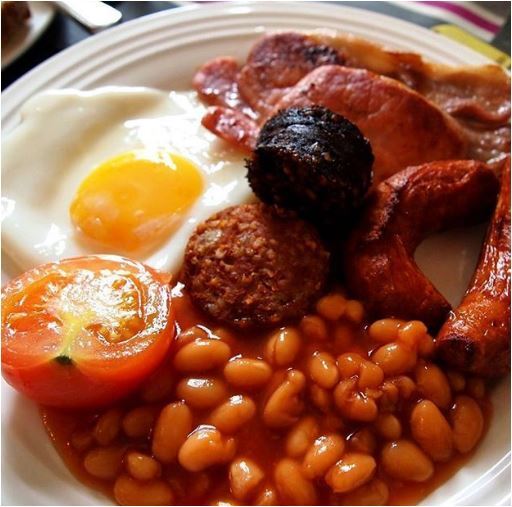
Christmas Day is often spent visiting family and friends, lots of eating, a bit of drinking, and sometimes attending a church service on Christmas morning.
Black and TanA popular festive drink is the Black and Tan – half Guiness and half beer.
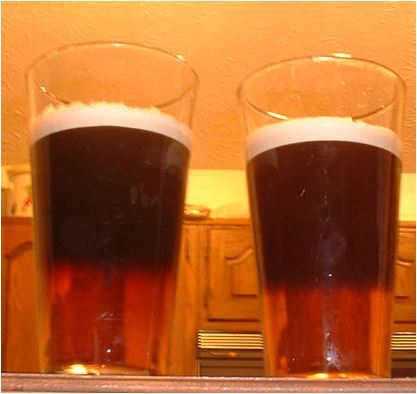

A traditional Christmas dinner in Ireland consists of roast turkey and stuffing, clove-studded baked ham, crispy goose fat potatoes, steamed Brussels sprouts, buttery sweet carrots, crispy parsnips, cranberry sauce, bread sauce, gravy.
…………………..
ScotlandThe celebration of Christmas in Scotland has always been secondary to the festivals held in January such as Hogmanay and Robbie Burns Day, featuring the Burns Supper and the eating of the Haggis.
Around 3 p.m. each Christmas Day, many in Scotland gather around their televisions and watch the Queen’s Christmas message.
Christmas DinnerThe traditional Scottish Christmas Dinner is usually roasted turkey, served with roasted potatoes, roasted parsnips, stuffing (either force-meat and/or chestnut), bacon rolls and sausages, Brussels sprouts, carrots, and peas. This is usually served with gravy, bread, sauce and cranberry jelly. Other popular main courses may include – Roast Angus Beef, Roast Pork, Roast Goose, Venison, Salmon, Chicken, Pheasant or steak pie.
Traditional Scottish Dessert – The Clootie Dumpling
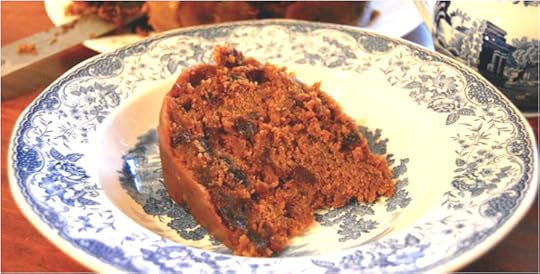
A clootie dumpling is a spiced pudding with dried fruits that is wrapped in a cloth and simmered in water. It is usually sliced and served with custard.
………………………
EnglandChristmas crackers are a traditional Christmas favourite in England. They were first made in about 1845-1850 by a London sweet maker – Tom Smith. He had seen the French ‘bon bon’ sweets on a visit to Paris (almonds wrapped in pretty paper).
When he returned to London, he decided to expand on the idea, and began to create the paper rolls including a small motto or riddle in with a sweet. Many today include a paper hat, or crown, and a small toy.

The tradition of sending Christmas cards began in England in 1843. Sir Henry Cole was a senior civil servant and he had the idea of exchanging Christmas Cards with family and friends. He asked his friend John Horsley, an artist to help. They designed the first card, and sold them for 1 shilling each.
Christmas cards became much more popular when printing methods improved, and were produced in large numbers from about 1860.
The first cards usually had pictures of the Nativity scene on them. In late Victorian times, birds and snow-scenes became popular.
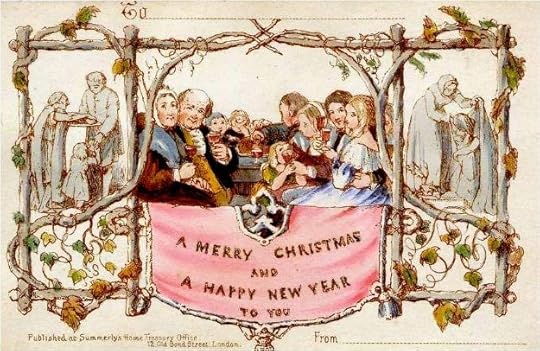
As early as the 13th century, medieval monks in Britain were known to drink posset, a warm ale punch with eggs and figs. A 17th century English recipe uses a heated mixture of cream, whole cinnamon, mace, nutmeg, eighteen egg yolks, eight egg whites, and one pint of wine. Eggnog is typically made from milk, eggs, sugar and flavourings, and served with cinnamon or nutmeg. While eggnog is often served chilled, it may be warmed, to serve on cold days.

Sometime in the 16th century devout Christians began the custom of bringing decorated trees into their homes. Some built Christmas pyramids of wood and decorated them with evergreens and candles. It is said that Martin Luther, the 16th-century Protestant reformer, first added lighted candles to a tree. Legend says he was walking toward his home one winter evening, composing a sermon, he was awed by the brilliance of stars twinkling amidst evergreens. In order to recapture the scene for his family, he erected a tree in the main room, and wired its branches with lighted candles.

The tradition of the Christmas Tree was brought to North America by German immigrants.
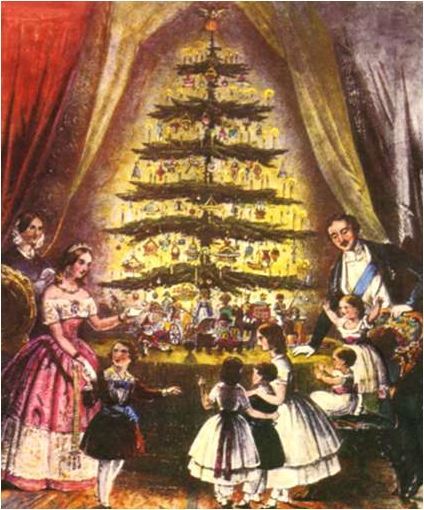
…………………
VenezuelaIn Venezuela, a predominantly Catholic country, the nativity scene is far more popular than decorating with a Christmas tree or other ornaments. These may include not only the Holy Family and manger but the entire landscape of Bethlehem. There are often competitions within a town or city for the more elaborate nativity scene. It is a strict rule in Venezuela not to place the baby Jesus in the manger until midnight.

It is a tradition for the entire city of Caracas, Venezuela to roller-skate to mass on Christmas morning, the young and the old alike.

Traditional Venezuelan Christmas foods include ‘Hallacas’ – a mixture of beef, pork, chicken, capers, raisins, and olives that is wrapped in maize and plantain leaves and tied up with string into a parcel and then boiled or steamed afterwards.
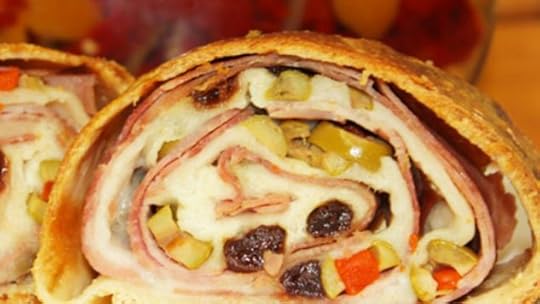
The legend of Santa Claus can be traced back hundreds of years to a monk named St. Nicholas. Nicholas was born sometime around 280 A.D. in modern-day Turkey. He was admired for his piety and kindness and St. Nicholas became the subject of many stories. Legends say that he gave away all of his inherited wealth, and travelled the countryside helping the poor and sick.
St. Nicholas was said to help the poor anonymously, by hiding gold in their shoes or stockings, at night, while they were asleep.

St. Nicholas’s popularity spread and he became known as the protector of children and sailors. His feast day is celebrated on the anniversary of his death, December 6. This was traditionally considered a lucky day to make large purchases, or to get married.
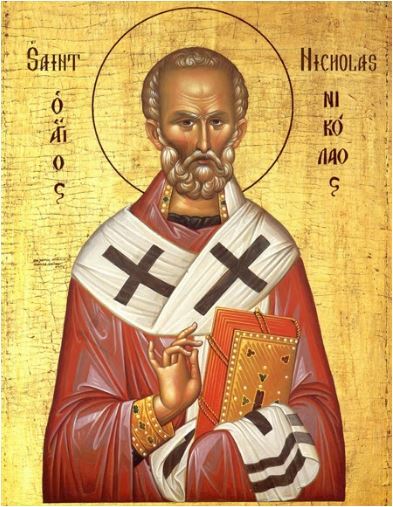
The name Santa Claus evolved from St. Nicholas’ Dutch nickname, Sinter Klaas, a shortened form of Sint Nikolaas .
The Dutch celebrate the Feast of Sinterklaas honouring the life of St. Nicholas, and although St. Nicholas is always shown wearing his bishop’s attire, the Dutch tend to see him as a kindly old man, rather than as a Catholic saint. The result is that Sinterklaas is celebrated by Dutch people of all ages and beliefs, without any real religious connotations.
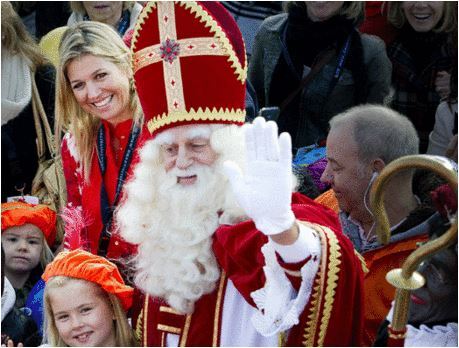
Christmas traditions are taken very seriously in Iceland. The whole house is cleaned, everyone gets one new article of clothing to wear, people buy the best food they can afford, decorate the house inside and out, and bake dozens of cookies.

Icelanders celebrate 13 days of Christmas. The festival begins on December 24 and ends on January 6, which is when all Christmas decorations are removed from streets and houses.
The people of Iceland enjoy a roasted pork dinner with caramelized potatoes and pickled red cabbage.
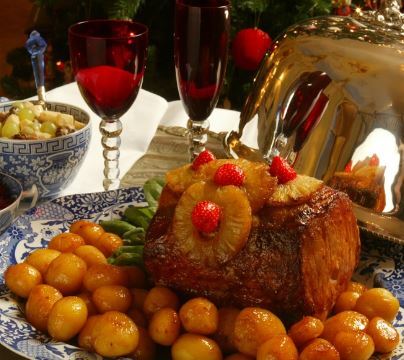
It is folklore in Iceland that there is a Yule Cat that stalks the towns and villages before Christmas and devours anyone who does not have at least one piece of new clothing.

In Ukraine, people love to sing Christmas carols in the street, and they make their way through the towns and cities.
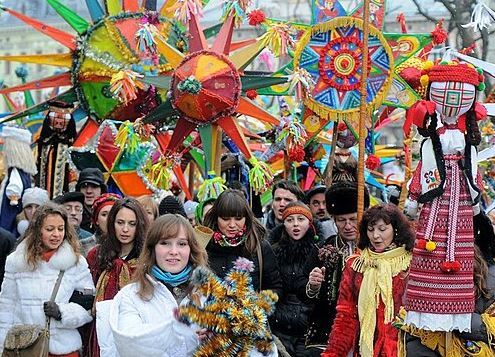
On Christmas Eve, people of Ukraine fast all day until the first star is seen in the sky, and then they begin to feast on cabbage rolls, perogies, sauerkraut, red ‘borsch’, dumplings, whitefish, ‘bigos’ (a meat and cabbage stew), cheese cake and bread.
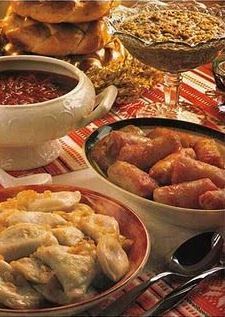
It is a tradition in Ukraine to decorate evergreen trees with glistening cobwebs. This is a custom that began with the tale of a poor widow who couldn’t afford to decorate her tree for Christmas, and the spiders in her home wanted to help, so they spun glistening cobwebs on Christmas Eve, so the children would have something pretty to see on Christmas morning.

The word “panettone ” comes from the Italian word “panetto“, a small loaf cake.
Italian legends tell about a banquet for the nobles organized by the Duke of Milan. The dinner was delicious but the dessert was forgotten in the oven, and when the cook finally realized it was too late, and it was dry and charred black.
Toni, a little kitchen-helper boy, told the cook that he could use the sweet cake he had made for himself in the morning. It was made of flour, butter, eggs, raisins and lime zest. The cook decided to accept the help of the little boy and the nobles loved the cake. When the Duke asked the name of it, the cook answered “ L’è ‘l pan de Toni”, meaning “the bread of Toni”.

Since the 1020s, the most important Christmas decoration in Italy is the Nativity Scene. Naples is the home to the world’s largest nativity scene. It’s in the ‘Museo Nazionale di S. Martino’ and has 162 people, 80 animals, angels, and about 450 other smaller objects.
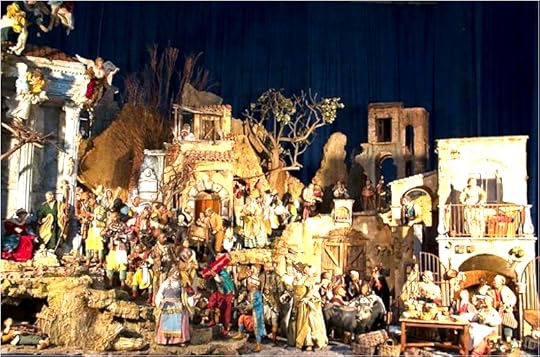
Would you be surprised to learn that over 90% of the people in Angola, Africa are Christians?

Stores and homes in Angola are decorated brightly for the season, and in the cities neighbouring families sometimes try to out-do each other with their elaborate displays.
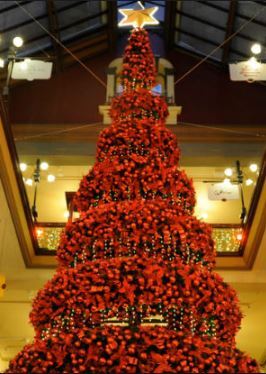
Along with traditional Christmas trees, the people of Angola sometimes decorate their homes with nativity scenes, along with strings of bright lights, angel figures, and star motifs.
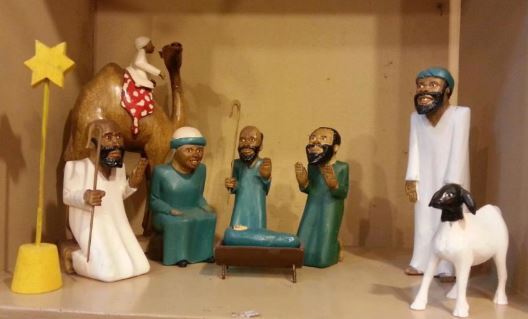
Bolo Rei, or ‘King Cake’ is a must at the Angolan Christmas dinner table. It is donut-shaped, and filled with dried fruit. The shape of the cake represents the crowns of the Three Wise Men: and the fruit on the surface of the cake represents the jewels on the crown. Sometimes a gift is hidden inside, and the person who gets the piece of cake with the gift is supposed to be blessed with good luck in the New Year.
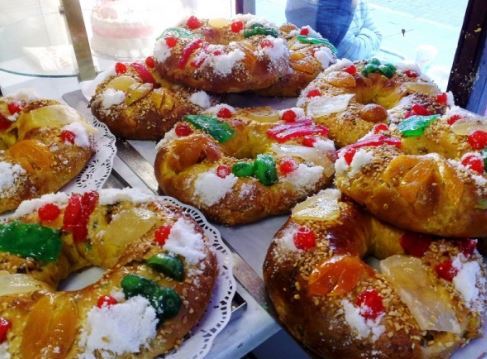
The Réveillon is the special feast shared with family on 24 December. It normally takes place leading up to Midnight Mass, and can even carry on after the church service is over.
The menu varies according to the region, but it is always an occasion for the family to sit down together and enjoy a variety of traditional dishes.
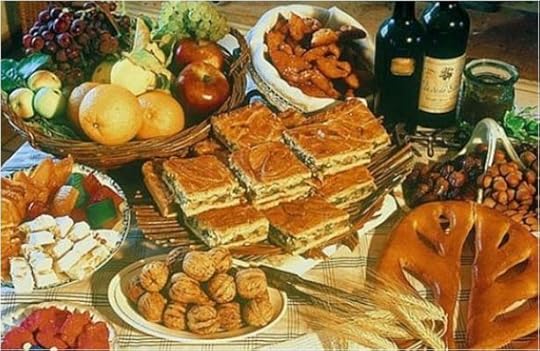
At the Reveillon the French indulge in luxury foods and treats. The Réveillon dinner can continue for up to six hours in some families, and it is a very sacred tradition to the French. Eating at the table for a long time is also a social custom in France, and is intended to be a magical and unforgettable moment for children too. This is the meal where everyone splurges on their normal food budgets and enjoys snails, frog’s legs, scallops, and truffles.
Typical beverages are champagne or sparkling wine, and desserts are typically a chocolate yule log – bûche de Noël
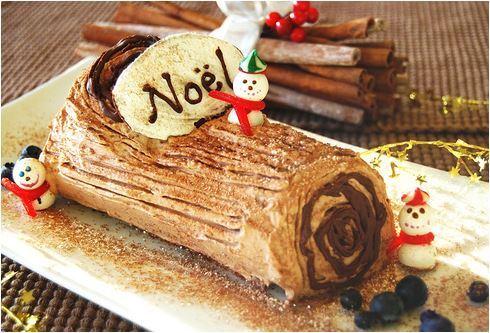
Christmas mass is an important tradition celebrated in Lebanon, as is the traditional dance, the dabkeh, where people join hands to form a circle or and stamp along to native tunes of percussion. After the midnight mass, it is the rush home to open Christmas gifts.

Traditional Lebanese Christmas feasts include – kebbeh pie, Lebanon’s national dish made from minced meat and burghul, served in warmed yogourt sauce alongside turkey or chicken, tabouleh, hummus, nutty rice, beet and tahini salad, and lamb rotis.
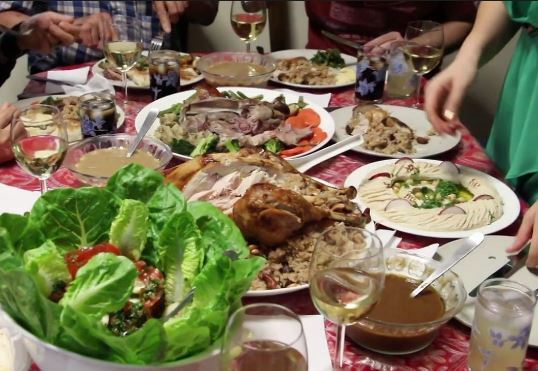
One of the most sacred Christmas traditions in Lebanon is building a crèche, or a nativity ‘Crib’. Nativity scenes include Joseph, Mary, Jesus, shepherds, and kings, just like Western ones, but there are some important differences in the Lebanese nativity. In Lebanon, the nativity ‘crib’ is modeled around a cave, not a manger, and is decorated with chickpeas, broad-beans, lentils, oats, and wheat seeds that grow and sprout from a damp cotton wool in the weeks leading up to Christmas. The nativity is an important part of the home and serves as a place for family members to pray and ask for blessings.

In China, most of the large Christmas celebrations take place in the cities, and sometimes crowds will gather in festive hats to usher in the season. ‘Jingle Bells’ is a popular song, and may be heard quite often in the weeks leading up to Christmas.

A popular tradition on Christmas Eve in China, is giving the gift of apples. Many stores sell apples wrapped up in brightly colored paper. Friends and family members exchange apples on Christmas Eve because in Chinese Christmas Eve is called “Ping’an Ye” (平安夜), which means ‘peaceful evening’. The word for apple in Mandarin is “píngguǒ” (苹果) which sounds like the word for peace.

Many of the school children participate in choirs, and sing traditional Christmas carols in the local malls, much to the delight of shoppers!

Christmas is a huge celebration in many Latin American countries. Most people go to a Midnight Mass service or Missa do Galo (Mass of the Roster). After the church service, which normally ends around 1 a.m. there are bright, loud displays of fireworks across the country in towns, cities, and villages.
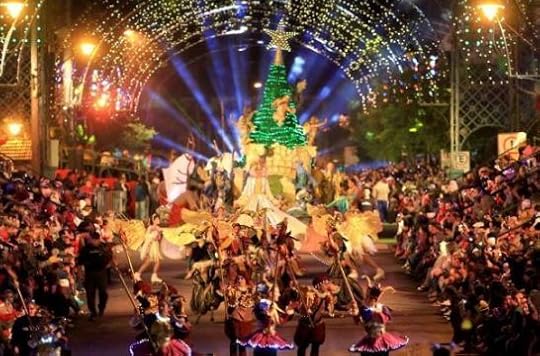
It’s common in Brazil to get a ’13th salary’ on the last week of the year – so in December you get twice the normal amount of pay for that month! This tradition began as a way to boost the economy around Christmas, and has been going on for decades.
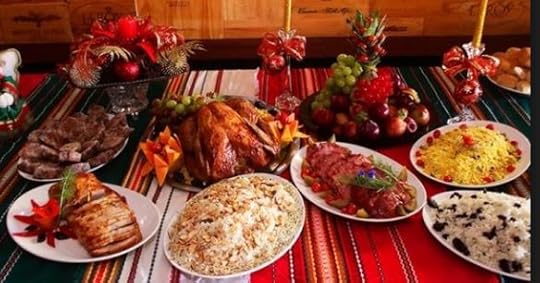
Families gather together around the table and enjoy food and special Christmas treats. Christmas dinner menu includes turkey, ham, rice, vegetables and fruit dishes.
The feast may begin on Christmas Eve around 9 pm, and in some homes the meal starts at midnight, with the children being served first.
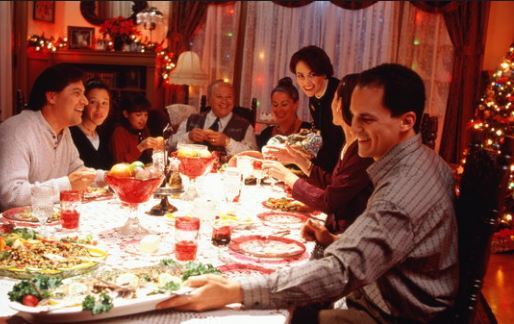
Kalanda (carol) – in Greece, children go from house to house singing Christmas songs, while playing a variety of small instruments, such as triangles, drums, lyres, and guitars
It is a custom for the recipient of Kalanda to gift the children with small treats, like chocolates, pastries and candy, though this can also be small gifts of money.
Kalanda’s are also sung on the eve of both New Years and Epiphany.
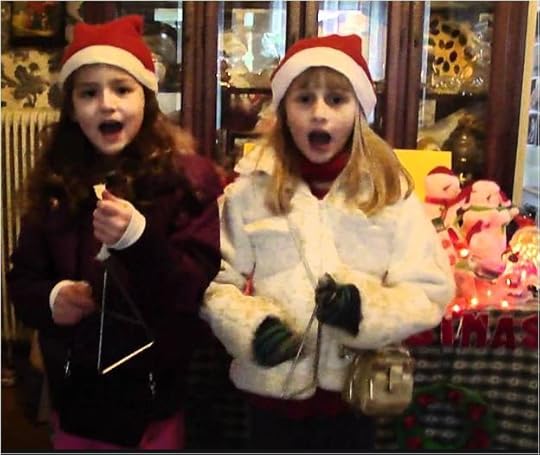
Christopsoma, also known as Christ’s bread, has been made in Greece at Christmas for hundreds of years. The bread is made in the shape of a circle, X, with a cross adorning it. Christopsoma is made Christmas Eve, and eaten Christmas Day.

Russian Orthodox Christmas takes place on January 7th ( or those following the Old Calendar it is held on the 25th of December).
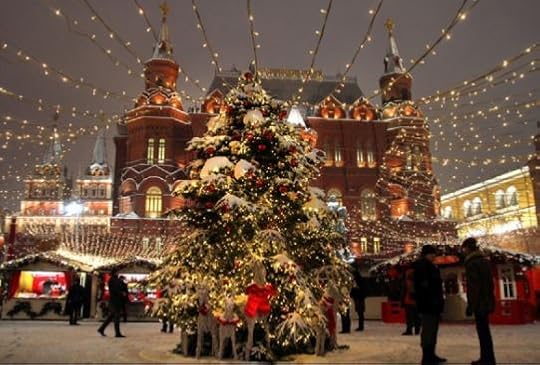
It is a Russian tradition not to eat or drink on Christmas Eve until the first star appears in the sky. The star is symbolic of the great star that led the three wise men to baby Jesus. Once the first star has appeared in the sky, the festivities begin with a Lenten meal. No meat nor dairy products are consumed and this meal is called the Holy Supper.
Most families stay home on Christmas Eve and they gather around the table to honor the coming Christ Child. A white tablecloth is draped on the table to represent Christ’s swaddling clothes and hay is displayed as a reminder of the poverty of the place where Jesus was born.
The Holy Supper consists of 12 main foods – symbolizing the 12 apostles:
Mushroom soup, Flat bread ,Chopped garlic, Honey, Baked fish
Fresh Oranges, Figs and Dates, Nuts
Kidney beans seasoned with shredded potatoes,
Boiled Potatoes , Biscuits with poppy seeds.

Perhaps of all the places in the world to be on Christmas Eve, Bethlehem would certainly be a special place to visit! A festive dinner is held at Bethlehem’s Manger Square and a broadcast of the Midnight Mass can be heard throughout the downtown. The streets are strung with Christmas lights, and Christmas music and plays are held throughout the evening.
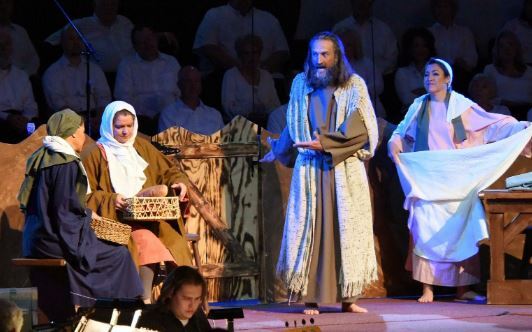
Traditional Christmas food in Bethlehem includes lamb kebabs, pork chops, lamb cutlets, chicken steaks, kubba, grape leaves filled with rice and meat, sfiha and a selection of sweet pastries.
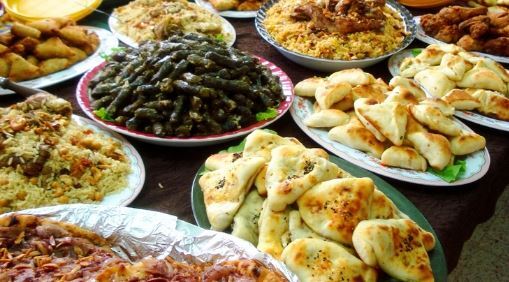
It’s often been said that the people of Bethlehem likely have one of the biggest celebrations, with days and nights of feasting, singing, lights, nativity plays, and the sky lit brightly with spectacular fireworks. With all of the excitement, celebrations, and festive fireworks it would be almost impossible for someone in Bethlehem to forget that it was Christmas!

……………………………………….
Your Family TraditionsWhatever customs you and your family celebrate during the Christmas season it’s a great time to think back to childhood days, and perhaps revive long-forgotten traditions. What better way for a family to remember its ancestors than by learning about their Christmas celebrations and customs!
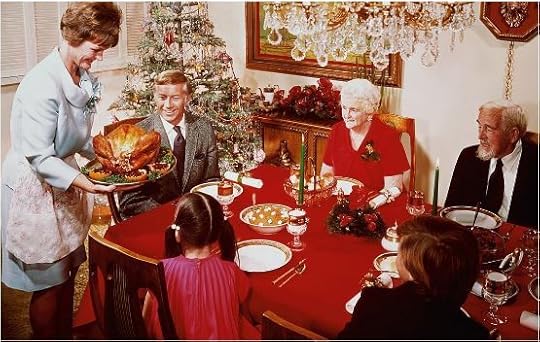
If your Christmas includes a large family gathering this year, don’t forget to take this opportunity to speak with your parents, aunts, and uncles, and ask them about their own childhood Christmas traditions.
 Share and Record Christmas Memories and Traditions
Share and Record Christmas Memories and TraditionsEncourage the younger members of the family to spend time with their elders, and learn more about their family history, and customs that they experienced in their youth. Make a video of some of the eldest family members, ask them questions about what Christmas was like when they were children. How is it different now?
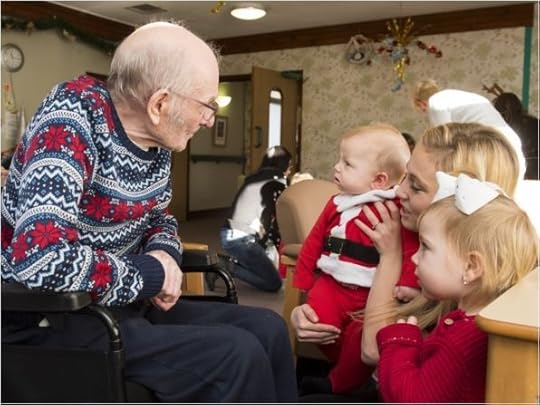
Be sure to spend time with the children and young people in your family, and share some stories with them about your own Christmas traditions and what it was like when you were a child!

Whether your ancestors came from Ireland, Iceland, or Israel, our customs passed down through the generations are an important part of the Christmas season.

Wherever your family came from, and whatever special foods, music, decorations, and folklore are part of your celebrations this year, have a very Merry Christmas!
……and good health, happiness and prosperity in the New Year!
………………………………………………………………………………………………………..
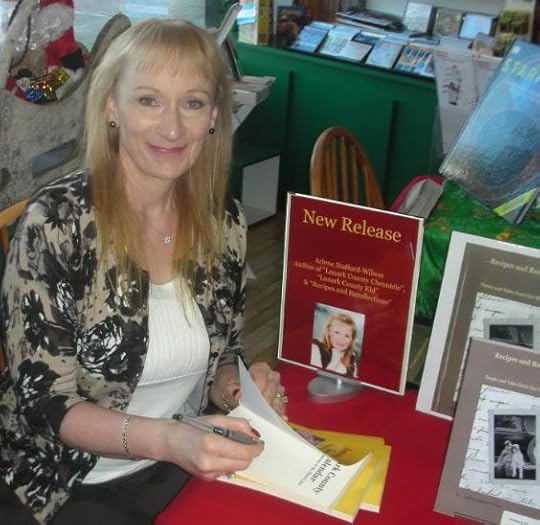
Arlene Stafford-Wilson
About the author: https://arlenestaffordwilson.wordpress.com/about/
December 13, 2021
Ferguson Falls 1929
An article appeared in “The Ottawa Evening Citizen”, on Saturday, September 28, 1929, by George R. Wilson. Transcribed below, it gives us a view into the past, who was living there at that time, and some of their recollections.


“Ferguson’s Falls in Drummond Township, county of Lanark, 13 miles to the rear of Carleton Place, is a beautiful little hamlet which has seen better days. At the present time, the village is endeavoring to achieve a reputation as a summer resort and a fishing center, and succeeding pretty well.
But there was a time back in the 1860s when the Falls boasted a sawmill, a grist mill, and a tannery and other enterprises and looked forward t finding a place on the map. The two mills were operated by water power which was provided by a dam across the Mississippi River. By the way, we omitted to mention that Ferguson’s Falls is located on the Mississippi River.
Just how the place got the name of ‘falls’ is hard to understand as there never was any natural waterfall there. There always was a rapids, as far as can be learned, but the drop in the river was never, according to old inhabitants, sufficient to be honoured by the name of ‘falls.”
A Dam Was Built
About 1850, Robert Blair built a dam across the river and thus created an artificial ‘fall’. On the north bank of the stream he built a sawmill, and on the south bank a grist mill.
Blair’s dam in high water flooded the low lands up the river and the farmers naturally objected.
In the 1870s, fire visited one mill after the other. Then, the farmers above the dam got busy and induced to government to prevent Mr. Blair from rebuilding. Soon afterwards the government removed the dam and now the waters of the river have free flow.
Named for Military Officer
The site of Ferguson’s Falls appears to have been originally owned by one Captain Ferguson, a disbanded military officer, who received his grant back in the 1820s from the Perth military settlement office.
Ferguson’s Falls is on the highway between Perth and Renfrew and other points. The road between the Falls and Perth, a distance of 13 miles, was originally a “forced” road.
Seven Irishmen
Local tradition has a story of how seven Irishmen, all young men, in the early part of the 1800s, came from the St. Lawrence to Perth by the existing road, and then hewed a trail through the unbroken forest to the district just northwest of what is now Ferguson’s Falls.
These seven young Irishmen are said to have been the first settlers between Perth and Chief McNabb’s Scotch settlement around White Lake.
Mr. Thomas Holliger, who tells about these seven pioneer Irishmen, recalls the name of four of them as Quinn, Carberry, Hartney, and Neville. Descendants of these men are still in the locality.
(note: the Seven Irish Bachelors were: Patrick Quinn, John Quinn, James Carberry, William Scanlan, Terrence Doyle, John Cullen and James Power)
Busy Place Once
At one time Ferguson’s Falls boasted three hotels and a post office, which was kept by Robert Hick. Today there is no post office at the Falls. To reach a resident of the Falls by mail, one addresses him or her via R.R. No. 1, Lanark.
The Falls today has a small sawmill, but it is not operated by water-power. It is run by Louis Bedard.
Among the present residents of Ferguson’s Falls are Mrs. Gray, a widow, William McCaffrey, a retired harness maker, Alex Sheppard who runs a general store and blacksmith shop, William Dickenson who conducts a hotel, Charles Hollinger, Auctioneer and drover, Tom Command, Trapper, Thomas Hollinger, Farmer and owner of a number of summer cottages, Louis Bedard, sawmill. Hope we haven’t missed anybody.
The Falls boasts a fine cement county bridge
The marshy portion of the river just above the Falls has always produced a large crop of muskrats. They are still plentiful.”
note on William ‘Billy’ McCaffrey – he also owned the infamous local bar, known as The Stumble Inn. For more information on Billy’s pub:
Ferguson Falls and the Stumble Inn
Girl Was Drowned
Back in the 1860s, the Mississippi was a scene of a sad drowning. A Miss Kitty Felleter was drowned just east of the village. The boat upset while she was fishing. Miss Felleter and her brother, a bachelor, had lived together not far north of the village.
In the 1860s a lot of pork was packed at Ferguson’s Falls for use in the shanties. Mr. Charles Hollinger, grandfather of Thomas and Charles Hollinger, had an inspection office at the Falls, and the pork had to be passed by him for quality before it could be sent into the surrounding shanties. Mr. Hollinger also kept a hotel.
Road Was Only Trail
In the 1860s and 1870s the road between Perth, Ferguson’s Falls and Renfrew was still little more than a trail. Today it is a road to travel with a car.
Ferguson’s Falls is one of the most picturesque little spots in eastern Ontario.”
(article by George R. Wilson, Ottawa Evening Citizen, Sept. 28, 1929)
A Few Photos of Ferguson Falls, from August 2021


St. Patrick’s Roman Catholic Church, established in 1856, built on land donated by the Quinn family.

photo: St. Patrick’s Church, Arlene Stafford-Wilson sitting on steps. Photo: Alexander Duhaney, Aug. 2021
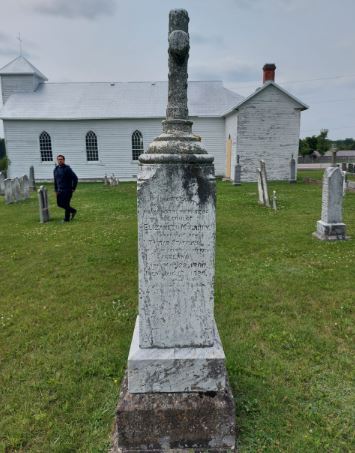
Gravestone of Elizabeth McGarry Stafford, originally from County Westmeath, Ireland, and in the background, her g-g-great grandson, Alex Duhaney, patiently waiting, but likely not as interested in visiting yet another old cemetery as his genealogist mother, Arlene Stafford-Wilson
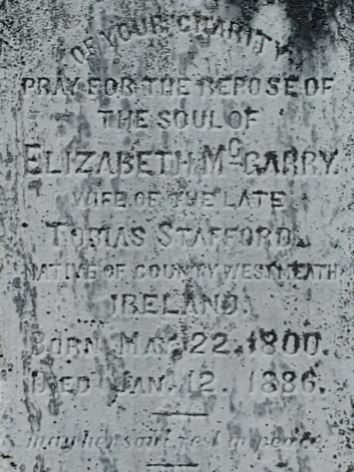
close up – Elizabeth McGarry Stafford, native of Co. Westmeath, Ireland 1800-1886
For more stories on St. Patrick’s Church and some history of Ferguson Falls:
St. Patrick’s Church, Ferguson’s Falls, Lanark County
For stories on the Irish Wakes of Ferguson Falls:
Irish Wakes
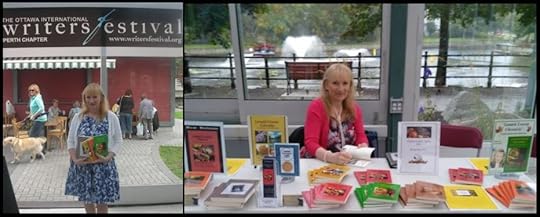
Arlene Stafford-Wilson
December 11, 2021
Soper Theatre, Smiths Falls
It was 1914 when local man, Bert Soper, opened the Rideau Theatre on Chambers Street, at the corner of Beckwith, in Smiths Falls. Stanley McNeill was the first manager. He was a local lad, son of Harry McNeill and Alice Butler, and he ran the theatre like a well-oiled machine.
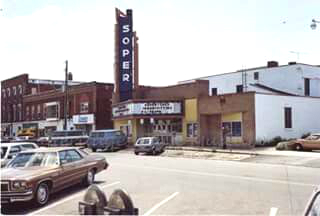
In the 1930s, the theater was renamed ‘The Capitol’, and people drove for miles around to come and see ‘Gone With the Wind’, ‘King Kong’, and “The Wizard of Oz”.

A new theater was built in 1949, at 15 Main Street in Smiths Falls. The new Soper Theatre boasted 964 seats, making it the largest movie theater in Eastern Ontario.
The Soper was managed by Walter Lackenbauer, a man who took his job very seriously. It was said that Walter was so punctual that you could set your watch when you saw him walking across the bridge, on his way to work each day.
When Walter Lackenbauer retired in 1976, Art White became the Manager of the Soper, and worked in that capacity until 1992, and then Jan Stepniak took over the position.
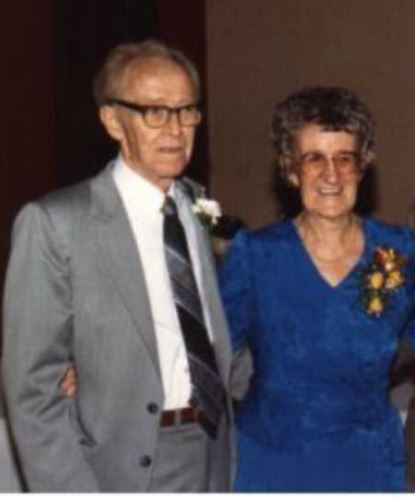
Another familiar face at the Soper Theatre was Violet Gariepy, a native of Scotland, she worked at the candy counter along with Norma Willoughby, and Jessie Loucks.
This is the clock that hung on the wall in the concession counter at the Soper. *

Some of the early films shown at the Soper, were ‘tame’ compared to the movies produced today. Films like ‘Snow White’, and ‘Old Yellar’ were suitable for the whole family.


One of the most popular movies in the 1950s was “The One That Got Away”, – the story of a German prisoner of war, Franz von Werra, who escaped from a moving train, as it passed through the town of Smiths Falls.
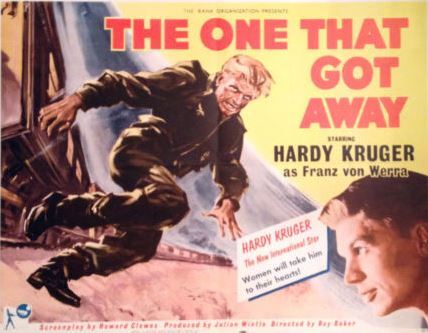
By the time I was old enough to attend a movie, the Soper Theatre was the only place in the area where we could go to see the newest Hollywood films. The Soper was just around the corner from the Sweet Shop – talk about a great location!
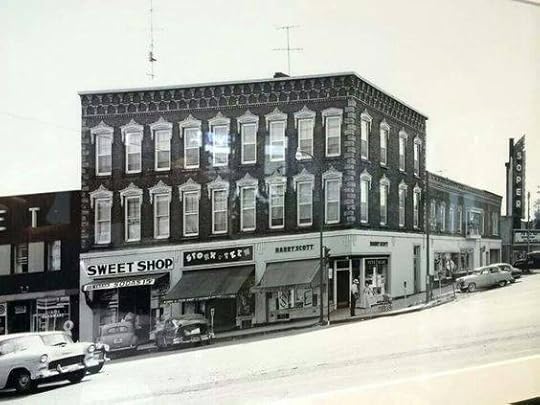
The Ushers who worked at the Soper Theatre might have been the original ‘multi-taskers’, who had a variety of jobs. These were the ‘boys’ who helped young children to their seats at the Saturday matinees, who shone their flashlights on young lovers in the back row, and did their best to keep the smoking and drinking from getting out of hand.
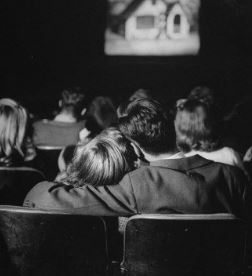
The same ushers had to walk back to the green seats, and remind smokers that their policy was cigarettes only, no cigars. They also had to police the drinkers, the kids who liked to sneak in mickey bottles in their jackets and have a few drinks on a Friday night.
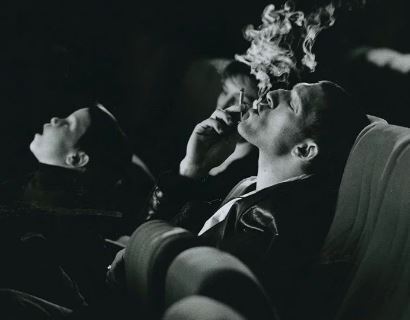
The mickey, invented in Perth, by John McLaren, was just the right size to sneak into the movies!

Some of the ushers who worked at The Soper, over the years: Gordon Evoy, Scott Irvine, Ralph Scott, Grant Dopson, Rob Knapp, Donnie Lackey, Ricky Laming, Tommy Martin, Bert Stranberg, Joe Gallipeau, John Marks, Brian McDougall, and Hugh Finlayson.
The big blockbuster movies in those days were some that we’ll never forget. According to many of the former staff members at the Soper, these movies were among the ones that brought in the biggest crowds in Smiths Falls:

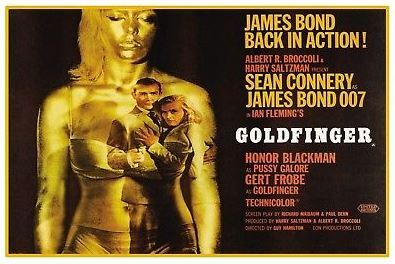

No one wanted to swim the year that this one came out –

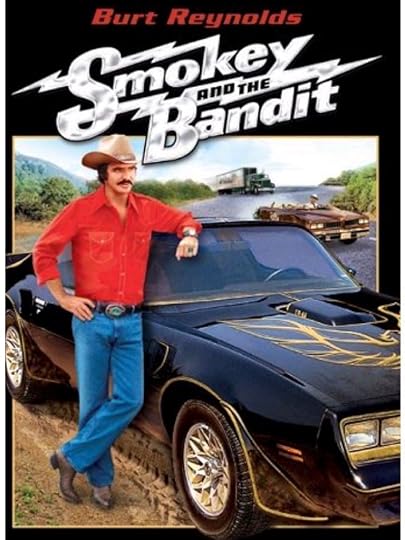
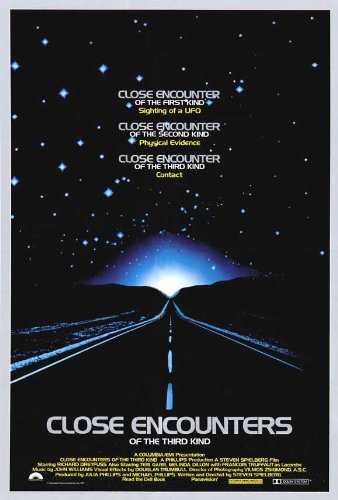
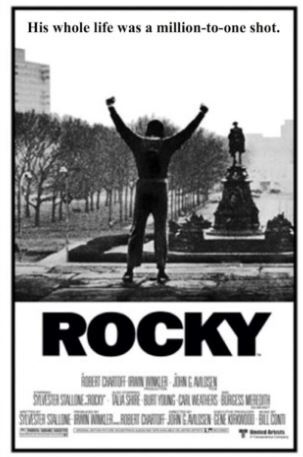

On the opening day of Jurassic Park, staff members, like Tammy DeSalvo, dressed up as dinosaurs, much to the delight of local children!


Sometimes we forget that it’s the people we don’t see at the theater, the ones who work behind the scenes, who play some of the most important roles. Rae Murphy was Projectionist at the Soper Theatre when the building was brand new, in 1949. The back-up Projectionist was Widge Williams, son of Bill Williams, owner of the Port Elmsley Drive-In Theatre.
Everyone’s favourite place at the Soper Theatre was the candy counter, and along with Violet Gariepy, you could find Gail Preece, along with brother and sister team – Christine and Stephen Harper, and twins David Morris and Stephanie Morris. David later became a police officer for the Town of Smiths Falls.
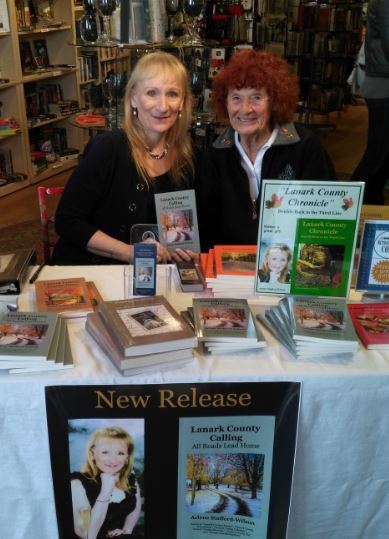

Many of us will never forget our very first movie, and for those of us who grew up in the area, the Soper Theatre was our first experience in a real movie theater.
The very first staff-member we encountered might have been Phyllis Evoy, at the ticket booth, or Violet Gariepy at the candy counter.

We may have noticed a very serious man, Walter Lackenbauer, the Manager, walking around the lobby, making sure that everything was running smoothly. Maybe we’d catch a glimpse of Rea Murphy, on his way to the projection booth, or one of the helpful Ushers escorting a child, or an elderly person, safely to their seat.
Although most of us have been to more modern, slick, new theaters since our nights at the Soper Theatre, those special, magical nights of our youth will remain forever in our hearts.
*note – the photo of the red Coca-Cola clock that hung on the wall of the candy counter was provided by Violet Gariepy. Violet’s husband Raymond became ill, and Jan Stepniak visited Ray in the hospital. Ray told Jan how much he had always loved the clock from the candy counter. Jan came to their home later, and presented Ray with the clock. Ray sinced passed away, and the clock hangs proudly on Violet’s wall, a treasured memory of her time working at this much loved theater.Photos of the Soper Theatre: Steven Maddock of Hyfund StudioFor more information on John McLaren of Perth, inventor of the ‘mickey’John McLaren of Perth, inventor of the mickey…………………………..
Discover the fascinating people in Smiths Falls who made the magic happen at the Soper Theatre. Learn about the lively staff Christmas parties, find out who went to the Rideau Hotel every night after work and why, and which one of the staff was married to a well-known hockey player. Read about the daily operations, behind-the-scenes at the Soper. Learn about a controversial court case when a Perth lawyer brings charges against a local film distributor. Meet the people who ran this beloved theater – the managers, the projectionists, the ushers, the candy-counter workers, and the people at the ticket booth, and read their memories and stories of this very special place! Go behind the scenes at this beloved theater in – “A Night at the Movies: The Soper Theatre in Smiths Falls”, in ‘Lanark County Calling – All Roads Lead Home’.

December 10, 2021
Irish Christmas in Lanark County
The Irish brought their Christmas traditions when they settled in Lanark County, in the earliest times. Our ancestor, Tobias Stafford, came in 1816, from County Wexford, Ireland, and married Elizabeth, ‘Betsy’ McGarry, who came from Mullingar Parish, County Westmeath, Ireland.
Christmas, in those times was a far more religious, and far less commercial holiday than it is today. Priests traveled from larger centers, like Perth, to smaller communities, and people gathered at one of the larger neighbourhood homes to hear mass, and to celebrate the birth of Christ. In 1856, St. Patrick’s Roman Catholic Church was built, on a gentle hill, overlooking the Mississippi River. Finally, the locals had their own church, not just to mark religious holidays, but also a place to witness baptisms, weddings, and to seek comfort at the funerals of their dearly departed.

St. Patrick’s Roman Catholic Church, built in 1856, Ferguson Falls, Ontario
Advent Candles
One of the early Christmas traditions at St. Patrick’s Church was the lighting of the Advent Candles.
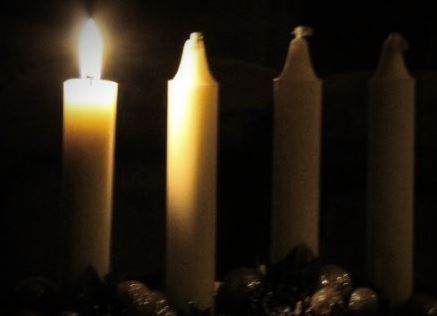
Four candles were set up at the front of the church, and one was lit at each of the four Sundays leading up to Christmas.
1st Sunday of Advent
The first candle was lit with a sermon on being watchful and alert, waiting for Christ’s arrival:
“Therefore, stay awake! For you do not know on which day your Lord will come.” Matthew 24:42
2nd Sunday of Advent
On the second week, the next candle was lit, with a sermon focusing on making preparations for the birth of Christ:
‘Prepare the way of the Lord, make straight his paths.’ Matthew 3:3
3rd Sunday of Advent
On the third Sunday of Advent, after the lighting of the third candle, the sermon focused on St. John the Baptist, and the foretelling of Jesus coming to earth:
“I am baptizing you with water, but one mightier than I is coming.” Luke 3:16-17
4th Sunday of Advent
Week four of Advent was the lighting of the fourth candle, and a reflection on the unwavering faith of Mary and Joseph, and a call to those who believed in what was to come:
“Blessed are you who believed that what was spoken to you by the Lord would be fulfilled.” Luke 1:45
Thomas Stafford’s Family
Thomas Stafford, the youngest son of Tobias and Betsy, was just 10 years old when St. Patrick’s was established, and so, he attended the church as a child, and throughout his entire life, with his own children, as he remained on the ancestral Stafford property, on the 11th concession of Drummond Township.
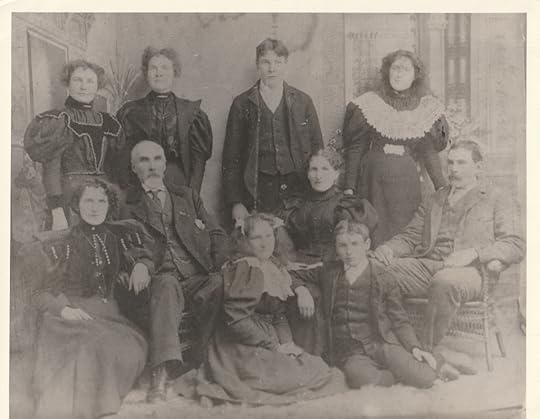
Family of Thomas Stafford, his wife, Mary (Carroll) Stafford, seated with their eldest son, Peter in the middle row. Back row – Ann Stafford, Mary Stafford (local schoolteacher in Ferguson Falls), Thomas Patrick Stafford, and Julia Stafford (who married William Quinn), front row – Margaret Stafford, Anastasia ‘Stasia’ Stafford, and Michael Vincent ‘Vince’ Stafford, (my grandfather, named for his uncle, Rev. Father Michael Stafford, the Apostle of Temperance), photo taken 1896.
In the weeks before Christmas, dried fruits were soaked in whiskey and rum, and more alcohol was added each day as the fruit became plump and full. A large, square piece of fresh clean cloth was dipped in hot water, and rubbed with flour to make it waterproof. After two weeks of soaking, the fruit was added to a traditional cake batter, and this ‘pudding’ was tied in the cloth sack, boiled for one hour, and then hung in the pantry to ripen.

Christmas puddings were hung in cloth sacks to ripen
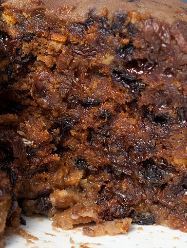
An Irish pioneer’s Christmas pudding
Christmas Decorations
Back in their homeland, the Irish decorated with sprigs of holly, ivy, and other evergreens native to Ireland like Arbutus, and Yew. Once in Canada, they used the native Eastern Ontario greenery – like spruce, pine, and cedar.

Small branches of spruce and cedar were brought into the home, and laid along the mantle
A spruce tree was cut from the surrounding forests, and brought into the house about a week before Christmas. White candles were attached to the tree, and lit in the evenings leading up to Christmas.
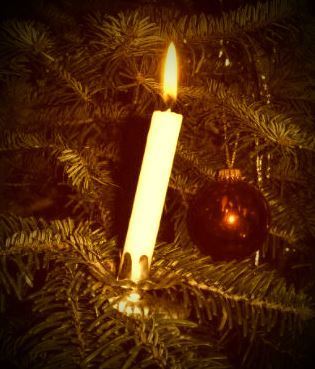
I recall our Dad saying that he was nervous when they lit the candles on the family tree because so many house fires were caused by this practice in the Ferguson Falls area, around Christmastime, when he was a young lad.
Shiny Christmas ornaments that we know today were very rare in the early days, and most of the decorative glass ornaments were imported from Germany, were very expensive, and only available in larger towns, like Perth, or Carleton Place. Often, the ladies of the family made homemade ornaments to hang on the tree, and some were made using needle-craft, like tatting, or crochet.
Lace Christmas ornaments were hand-crafted by the early settlers
Some of the more affluent families purchased ornaments imported from Europe
Precious and costly ornaments, imported from Europe
Bloc na Nollag – the burning of the Yule Log
The cold dark days and nights of the winter solstice were known as “Yule” in Ireland, and most of northern Europe. Burning the “Bloc na Nollag” (Nollag pronounced ‘null-egg’), was an old Irish tradition that continued through the generations, and was common to the Irish who settled in Eastern Ontario. The men of the family dragged home the largest log they could find. After dusting off the snow, the log was placed whole at the back of the fire. This large log was supposed to last for the entire 12 days of Christmas. A small piece of the log was saved to use as kindling for the lighting of the next year’s yule log .

Yule Log
A Candle in the Window on Christmas Eve
All through Ireland a candle is lit and placed in the window on Christmas Eve. This tradition was brought to Canada by the settlers, and was a symbol of welcome to the Holy family. It is thought that this custom originated with the tradition of lighting the way for all travelers on the winter solstice, the longest night of the year. It is a tradition for the eldest person in the family to light the candle in the window on Christmas Eve.
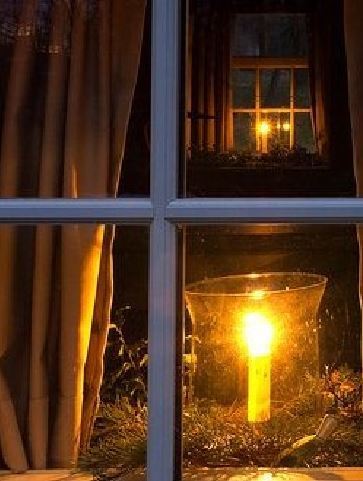
A candle lit in the window on Christmas Eve, lighting the way for the Holy Family
An orange in the Christmas stocking
According to Dad, they hung simple stockings, sometimes wool socks, without decoration, on Christmas Eve, and in the morning, the stocking would hold a few pieces of hard candy, a small toy usually made of wood, and always a lovely, ripe, Christmas orange. He said that fresh fruit was scarce when he was growing up in the 1920s, and it was a very special thing to receive a fresh juicy orange on Christmas morning.
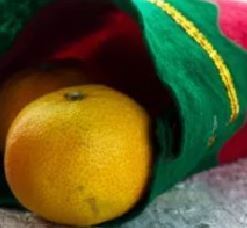
A simple stocking with a precious fresh orange was a treat in the 1920s, in Drummond Township
On Christmas morning, the family got dressed up in their best clothing, hitched up the horses to the cutter, and headed to St. Patrick’s Church.
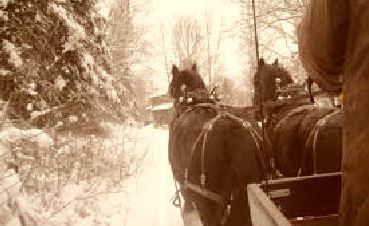
All of the families in the area donated a bit of money to the local priest, and presented it to him with thanks, at the end of the service. The custom came from Ireland and was known as the ‘priest’s box’, even though the settlers used an envelope, or folded paper together and sometimes painted colourful designs on the outside.

Envelope for a special Christmas donation for the local priest
Irish Christmas Dinner
Many of the traditional foods from Ireland were not available to the Canadian pioneer settlers, so they made a few substitutions when needed. Although goose was the traditional bird cooked for Christmas dinner in Ireland, the settlers sometimes roasted a duck, chicken, or turkey, instead. The clove-studded baked ham was a tradition brought from the old country, and cooked in our ancestor’s homes. Stuffing was made of bread crumbs spiced with sage, onion, salt and pepper. Potatoes were always a favourite daily staple, and they were usually roasted in the fat of the duck or chicken. Roasted carrots were served, along with gravy made with the poultry drippings. The plum pudding was boiled again on Christmas Day, then a whiskey or rum sauce was poured on the top and it was lit at the table, at the end of the Christmas meal, and served as dessert.

Traditional Irish Christmas dinner with ham, turkey, stuffing, carrots, potatoes, gravy, and Brussels sprouts

Clove-studded baked ham

roasted potatoes and carrots
After dinner, the leftover food was put away, the dishes washed, and chairs were moved close to the fire, placed in a semi-circle. This was a time for music! Fiddles were played, and traditional Irish songs from the old country were sang around the fire. Stories were told of Christmas’ past, and jokes were shared, generous glasses of whiskey were poured, and the dancing of a little ‘jig’ to go along with the music was common.
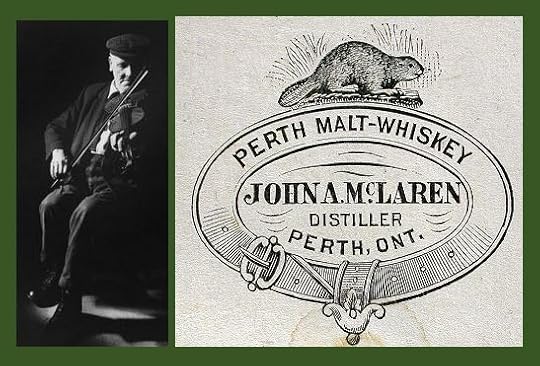
The merriment went on into the wee hours, and it was a tradition for the youngest in the family to leave the home’s door unlatched, before going to bed, to give shelter to any travelers who may pass by. When the story-tellers and the musicians grew weary, and the last soul in the house finally retired to bed, it was their task to make sure that the Christmas candle was still lit in the window, to help guide the Holy Family through the long, dark, night.
And so, the traditions and customs of our Irish ancestors were passed down through the generations, from the very first settlers, to the present day. The special Christmas foods, the hanging of the stockings, the lighting of the candles for Advent, the singing of songs, the fiddling, the whiskey, the story-telling, and the lone candle in the window, lighting up the dark, cold, December night.
So, I’ll leave you with a traditional Irish Christmas blessing, and hope that you will pass along some of your own family’s customs to the next generation, from your grandparents, to your parents, to you, and onto your children, and their children. Peace be with you and yours this holy Christmas season.
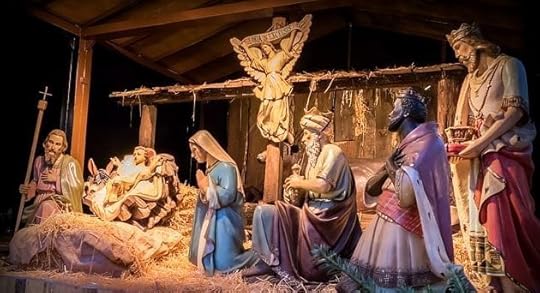


Arlene Stafford-Wilson
For more stories on Lanark County:
December 9, 2021
“The Curlers” -filmed in Perth
In 1955, a black & white film, “The Curlers”, was shot in Perth, Ontario. “The Curlers” is a story featuring many local actors, as well as members of the Perth Curling Club.
With a number of scenes shot on the main streets, Gore, and Drummond, as well as the area around the Curling Club, and some rural scenes, the film is a trip down memory lane, and a glimpse back into life in 1955.
The story unfolds as two members of the Perth Curling Club, who are also local farmers, have a dispute over a section of property where their farms intersect.

Early in the film we see scenes of Gore Streets, and Drummond Streets, and then we meet some of the town’s best curlers at the Perth Curling Club.

The Perth Curling Club, as it appeared in 1955.
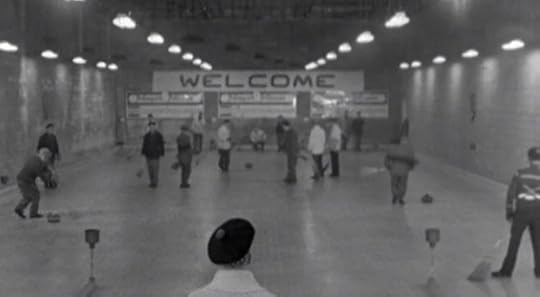
Members of the club appear in the film, along with actors portraying the main characters.

Producers remarked that the local actors did a fine job in their roles.
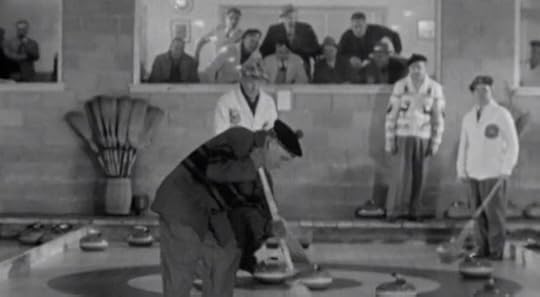
With so many Perth residents having Scottish ancestors it’s not surprising that curling was such a popular pastime in the winter months.

The conflict between farmers Henderson and McNair begins when it’s determined that trees have been chopped down on a section of property that each believes is theirs.

Back in Perth, along the main street, both men decide to seek legal counsel over their dispute
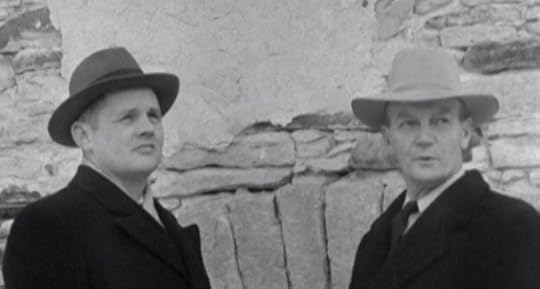
Each of the parties discusses the matter with their lawyers to determine the best course of action.
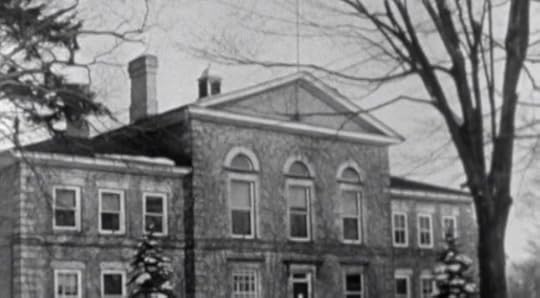
Another scene featuring one of the lovely limestone buildings in Perth – the historic courthouse.
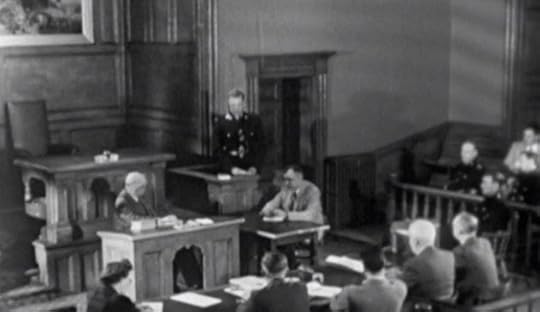
One of the scenes takes place inside the Perth Courthouse

A lunch meeting is held in a local hotel.

A scene inside the hotel.
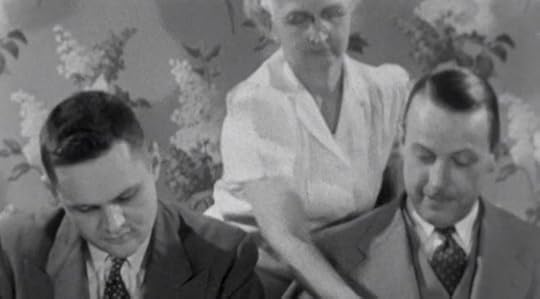
The two lawyers representing each of the farmers discusses the lawsuit over lunch.
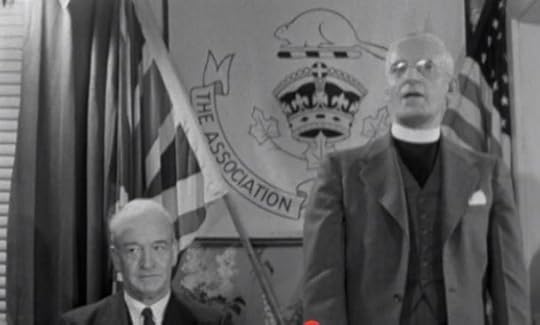
Lunch meeting with some of the town’s ‘movers and shakers’.

Turkey Fair Day – on Gore Street

Back at the Curling Club

The two farmers, still in conflict over the land dispute must play together against an opposing team…
What will be the outcome?
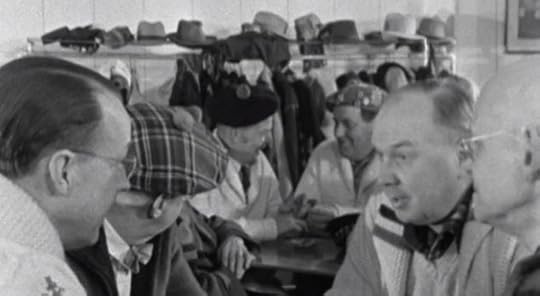
After the game…

At the local church on Sunday
Local actors…and members of the Perth Curling Club
“The Curlers”
Norman Klenman -Story and Screenplay
William Davidson – Director
Robert Humble – Photography
Clifford Griffin – Sound
Fergus McDonell – Editing
Nicholas Balla – Production

Watch the film in it’s entirety,
“The Curlers”
Click on the link below:
https://www.nfb.ca/film/curlers/
….and take a trip down memory lane
From the National Film Board of Canada:
“In this film we see how an ingenious small-town lawyer employs the team spirit to settle a rift between two neighbouring farmers, just in time for an all-important turkey bonspiel.”
photos: are from the film, “The Curlers”
For more local stories in and around Lanark County:

Arlene Stafford-Wilson
December 8, 2021
Haggis Candy – Goodies on Gore Street!
It was her father, James Haggis, who started the candy business in Perth, back in 1926, but it will likely be Sophia, who will always be remembered fondly, as the ‘Candy Lady’.
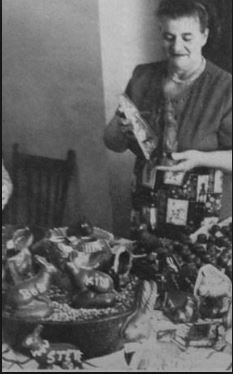
Sophia used the original equipment, passed down to her, from her father, like the big copper pots for melting rich, velvety, chocolate, and buttery peanut brittle.


Each year at Easter, Sophia made delicious chocolate bunnies and eggs, and would offer to personalize them with any name. She used a stiff white icing, and piped on the names by hand, as her eager audiences waited for their special egg to be completed.

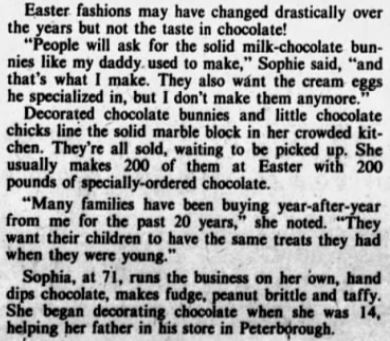

Haggis Candy was located on the main street of Perth, at 60 Gore St. E.
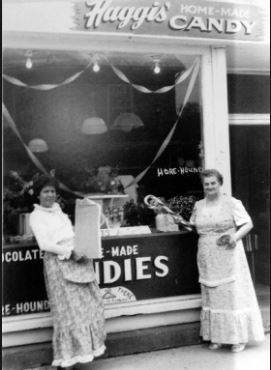
A very special time of year for Haggis Candy was Christmas, and Sophia decorated her store windows with her giant candy-canes, some of them almost six feet tall!

One of Sophia’s specialties was her Horehound candy. It had a very distinctive flavour, and some said that it was a good remedy for sore throats, and congestion. Most of her customers just liked its unique taste. People came from miles around to buy her Horehound.

Sophia made her candy from the Horehound Plant. The plants are picked, dried, and steeped with boiling water. The liquid is strained, sugar is added and brought to a boil, then cooled on a marble slab. The finished candies are cut into squares, and rolled in powdered sugar.

Another customer favourite was Haggis’ taffy. Sophia used the original steel hooks to pull her taffy, to just the right consistency.

…..and the finished taffy, ready to enjoy!
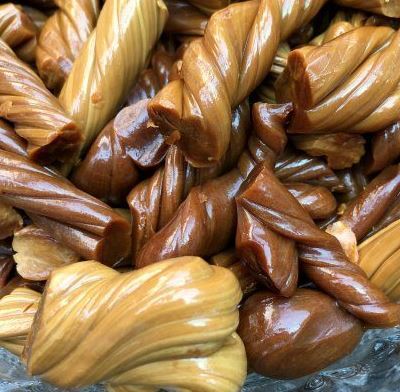
She used the marble slabs, passed down from her father, to cool her fudge quickly, so that it could be cut into squares.
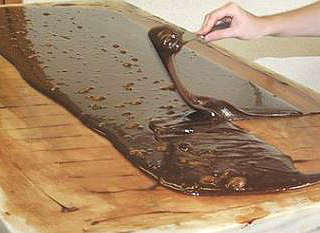
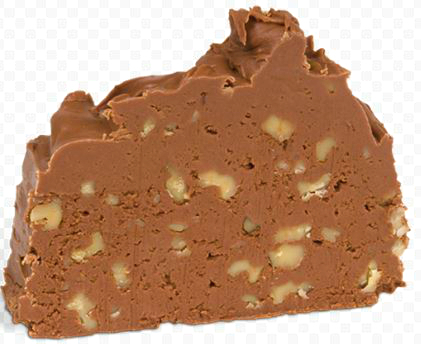
Sophia had a quick smile, and a warm personality. She loved following in the traditions of her father, and most of all loved to see the smiles on her customer’s faces when they tasted her delicious treats.
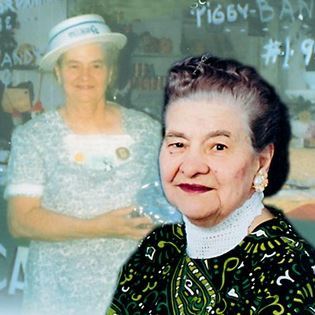
Haggis’ Candy store was where you’d often find my friends and I, after leaving Perth High School in the late afternoon. My personal favourites were Sophia’s milk chocolate peanut clusters, made with real Spanish peanuts! Sophia would place a few in a small, brown-paper bag, weigh them, and hand them to me with a smile. Sometimes I would bring them outside, walk down Gore Street, sit on the bridge, and watch the world go by, as I savoured my chocolate treats!

On hot, muggy, summer days, Sophia made the most delicious banana splits, and often tourists and locals alike, would stop by her store to sample some of her rich, creamy, creations.

In 1988, at the age of 77, Sophia retired from the candy business. She kept active in her later years, and continued to play the piano, as she had often done, at various events in Perth, over the years.
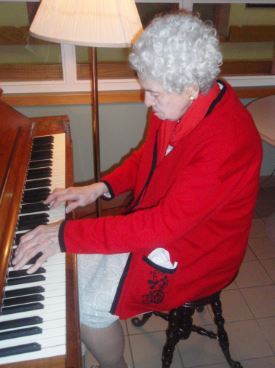
Sophia eventually left Perth, and moved to Kingston. She lived a long life, and there were many very happy birthdays over the years!

Sophia had a wonderful milestone birthday, when she celebrated her 100th! She still had her kind smile, and bright eyes.

After a long, happy, life, Sophia passed away at Providence Manor in Kingston, on Sunday, November 4th, 2012, at the age of 101.
She may be gone, but never forgotten, and many of us will treasure the memories of our childhood visits to Haggis’ Candy store.
She will always be fondly remembered as the ‘Candy Lady of Perth’.
………………
Read the fascinating story of Sophia Haggis Nee in “Lanark County Calling: All Roads Lead Home”. Learn about Sophia’s childhood in Peterborough, her grandfather the Lockmaster on the Trent Canal, her grandmother Sarah, the published Poet, and find out about her great uncle Samuel Lowry and his scandalous court case. Read about her days as a teenager at the Perth High School, and her chance meeting with the influential Mrs. Jack Stewart. Learn about Sophia’s most unusual trail-blazing career in Kingston, Ontario, before moving back to Perth to take over her ailing father’s business. Read memories of the happy days at the candy store, the customers, the ‘regulars’, and some surprising things about this much-loved lady and well-respected woman entrepreneur in the town of Perth, Ontario.
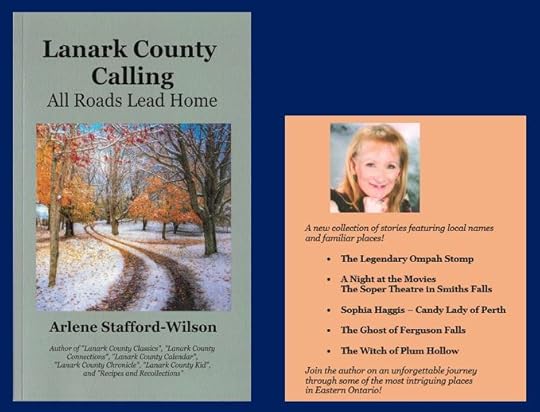
December 7, 2021
It’s a Wonderful Life – The Real Story

Opened December 1946
“It’s a Wonderful Life” opened in theaters across the country in December 1946. This much-loved family Christmas film was based on a short story called, “The Greatest Gift”. The initial tickets sales were disappointing, and early reviews were mixed.
The Movie Lost Money
The original film did not make a profit, and actually lost money. It was only many years later when the film became part of the ‘public domain’, it was allowed to be broadcast without royalty fees. It was during this re-release that television audiences made the film a yearly Christmas tradition in their homes.
“The Greatest Gift”
(the book that inspired “It’s a Wonderful Life”)
Philip Van Doren Stern began writing “The Greatest Gift” in 1939. Stern was a respected historian and was well known for his books and articles on the Civil War. He was born in a small town in Pennsylvania into a family of modest means, his mother Anne was a housewife and his father was a travelling salesman.

Philip Van Doren Stern (1900-1984)
“The Greatest Gift” was his first attempt at fiction. He wasn’t able to find a publisher, so Stern printed 200 copies and sent them to friends as Christmas gifts.

“The Greatest Gift”, by Philip Van Doren Stern, written 1939
One of these copies found its way to a producer at RKO Pictures, who offered to buy the motion picture rights. RKO (Radio-Keith-Orpheum) Pictures, was an American film production and distribution company operating from 1929 to 1959. A Producer at RKO showed the story to actor, Cary Grant, who said he’d be interested in playing the lead role. During these talks, RKO sold the rights to Director Frank Capra’s movie production company, Liberty Films, for $10,000. It was Frank Capra who adapted the story for the big screen.
Jimmy Stewart
Actor, Jimmy Stewart, played the lead character, George Bailey. Stewart was not sure if he wanted to accept the part. He had suffered some very traumatic experiences during WWII and for a while he considered giving up acting altogether, thinking that it was frivolous and not a worthwhile way to spend his life. When Stewart read the script, he was drawn to the story and agreed to do the film.
Photo: Jimmy with his parents and younger sisters, Mary and Virginia.
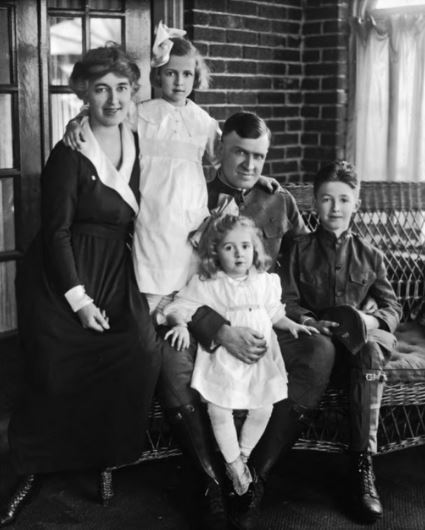
Jimmy Stewart’s family in 1918 – (young Jimmy is seated beside his father)
Early Life
James Maitland Stewart was born on May 20, 1908, in Indiana, Pennsylvania, the eldest child born to Elizabeth Ruth Jackson (1875–1953) and Alexander Maitland Stewart (1872–1962) Stewart’s father ran the family business, the J.M. Stewart and Company Hardware Store, which he hoped Jimmy would take over as an adult. Raised a Presbyterian, Jimmy was a devout church-goer for much of his life.
Stewart became the first major American movie star to enlist in the U.S. Army to fight in World War II. During the war he was promoted to the rank of Major following a mission to Germany, in January 1944. He was also awarded the Distinguished Flying Cross while he served as Deputy Commander, as well as the distinguished Air Medal. He was promoted to full Colonel in March of 1945, becoming one of the few rise from Private to Colonel in only four years.

Jimmy Stewart receiving a medal in 1944, for his service in WWII
It’s a Wonderful Life
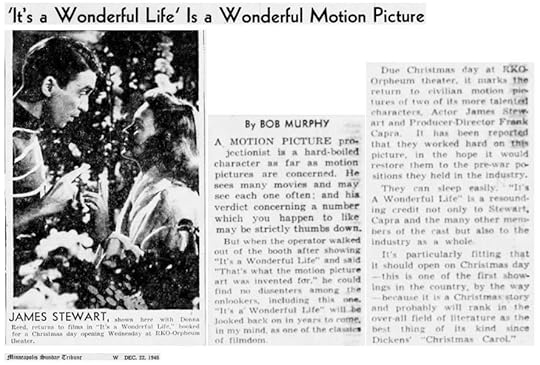
The Story
The plot centered on Bailey, a forlorn man who was considering suicide and wished he had never been born. In the story Bailey meets his guardian angel, who grants him his wish. Bailey soon realized that if he were gone it would leave a gaping hole in the lives of all his family and friends. This was a turning point that brought a renewed love for life and joy in living.

“It’s a Wonderful Life” opened the first Christmas after WWII ended. Even though the movie ended on a high note, the film didn’t immediately resonate with audiences. “Our movie just got lost,” said Stewart.

After 1974, the copyright for the movie lapsed, and television stations could broadcast the film at no cost.

A whole new generation watched the film, and its popularity soared throughout the 1970s and 1980s.

Over 80,000 people purchased a video cassette recording of the movie in 1986. In 1987, that number nearly doubled.
A Christmas Tradition
Watching the film became a Christmas tradition for many families.
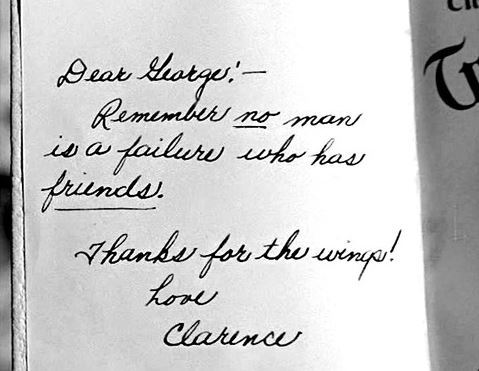
Later in his life, Jimmy Stewart remarked that “It’s a Wonderful Life” was his favourite movie, of all the films made.
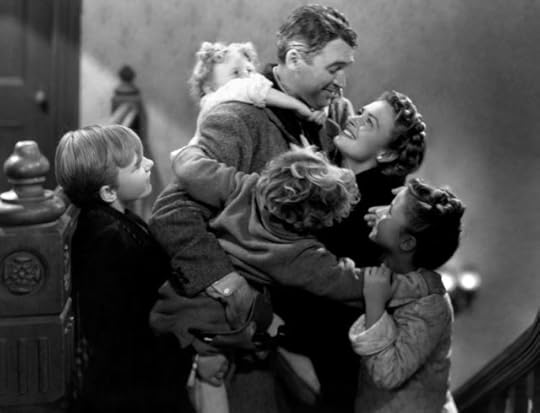
Jimmy Stewart’s ‘real’ family
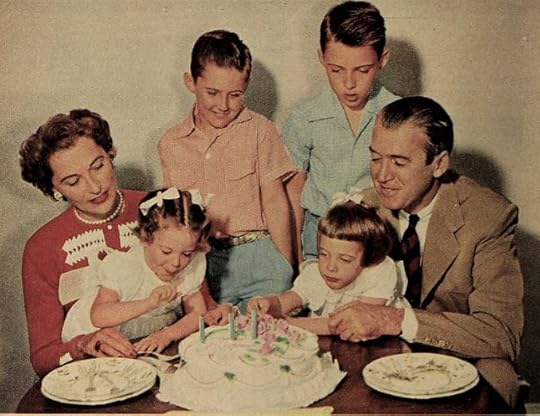
Photo 1954: Jimmy Stewart with his wife, Gloria, and their children Ronald, Michael, Judy and Kelly
Jimmy married in 1949 to his sweetheart, Gloria Hatrick. He waited until he was in his forties to marry, and so he was known for a while as ‘the great American bachelor’.
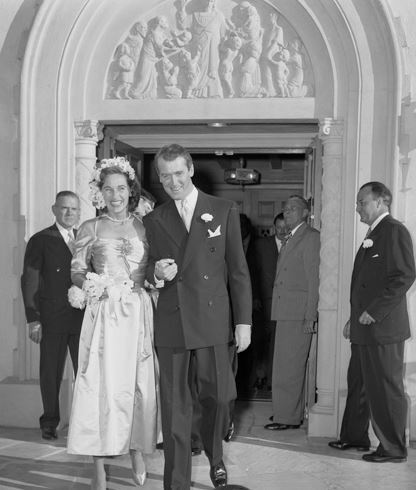
They bought a home in 1951, raised their family, and lived there happily together until Gloria’s death in 1994. Jimmy passed away three years later, of a heart attack, at the age of 89, on July 2, 1997. President Bill Clinton commented that America had lost a “national treasure … a great actor, a gentleman and a patriot”
Stewart is remembered for portraying the “every-man” character in his movies. His virtuous on-screen persona along with his real-life devotion to his own family made him a lovable representative of the male ideal, and he was considered to be one of the best-loved figures in twentieth-century popular culture.
Five of Jimmy Stewart’s films —Mr. Smith Goes to Washington (1939), The Philadelphia Story (1940), It’s a Wonderful Life (1946), Rear Window (1954), and Vertigo (1958)— are registered on the American Film Institute’s list of the 100 greatest American films of all time.
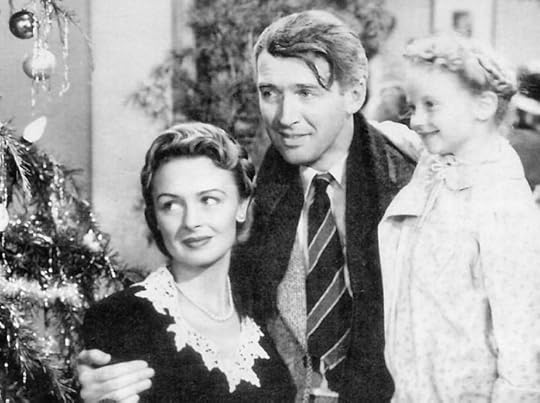
“It’s a Wonderful Life” is considered to be one of the greatest Christmas-themed movies ever made.
Enjoy this much-loved movie with your family, and make it part of your own Christmas traditions!


Arlene Stafford-Wilson

